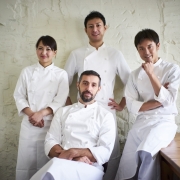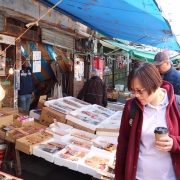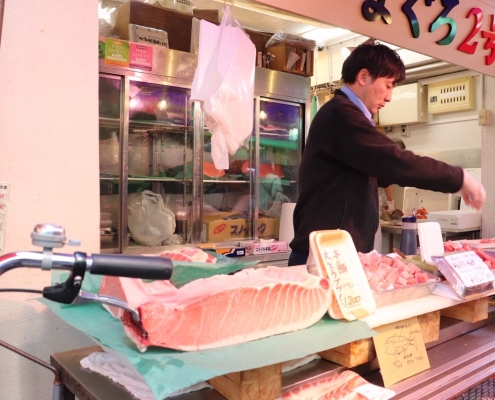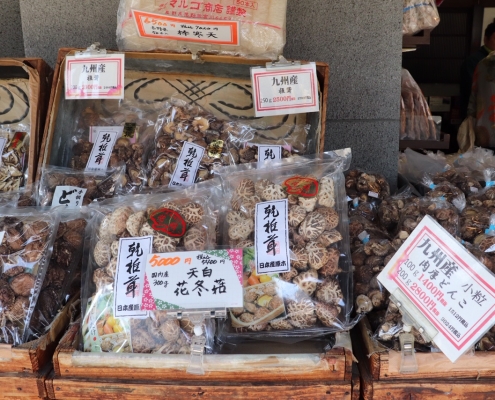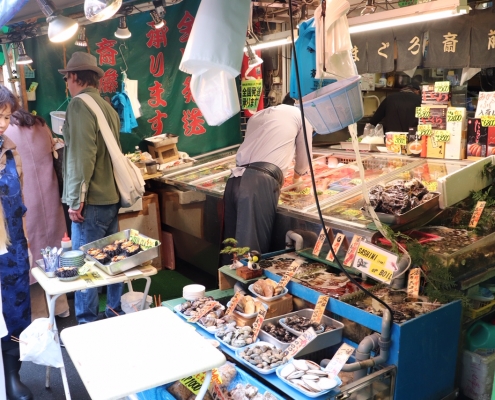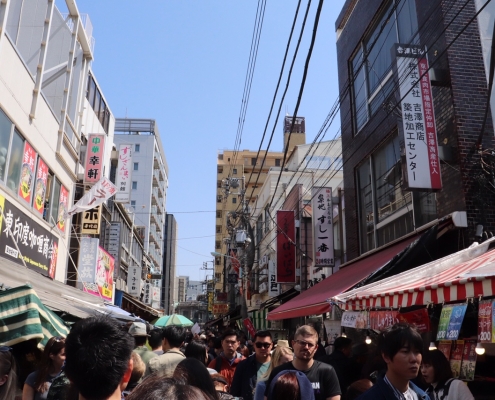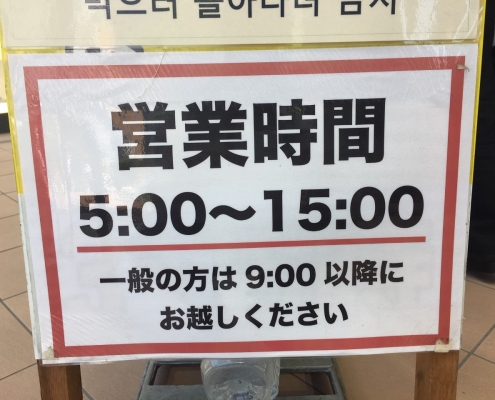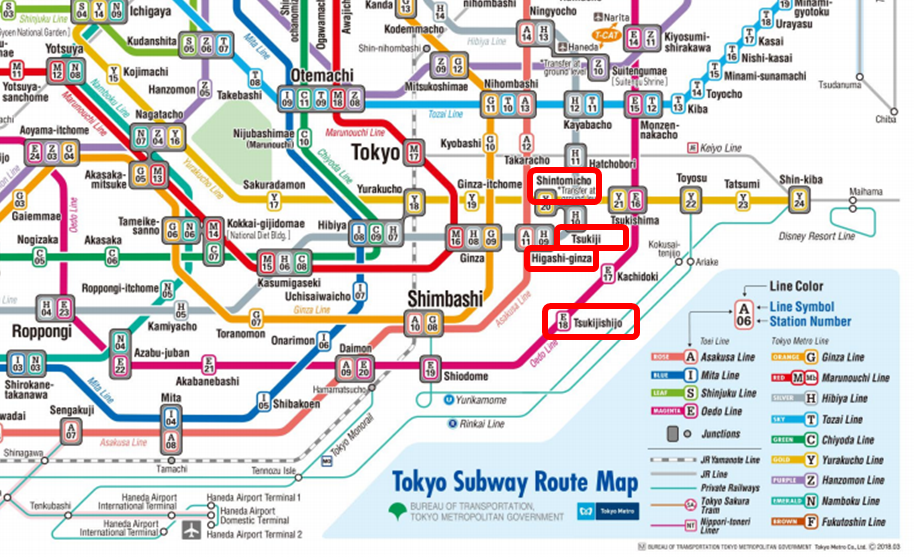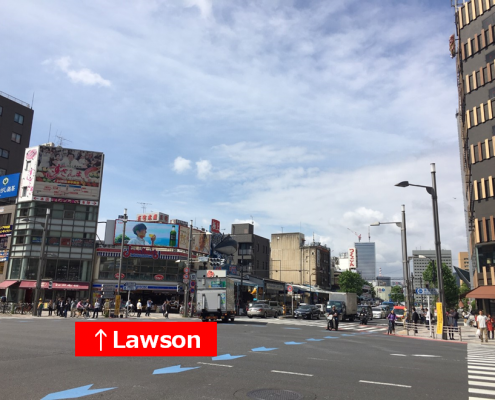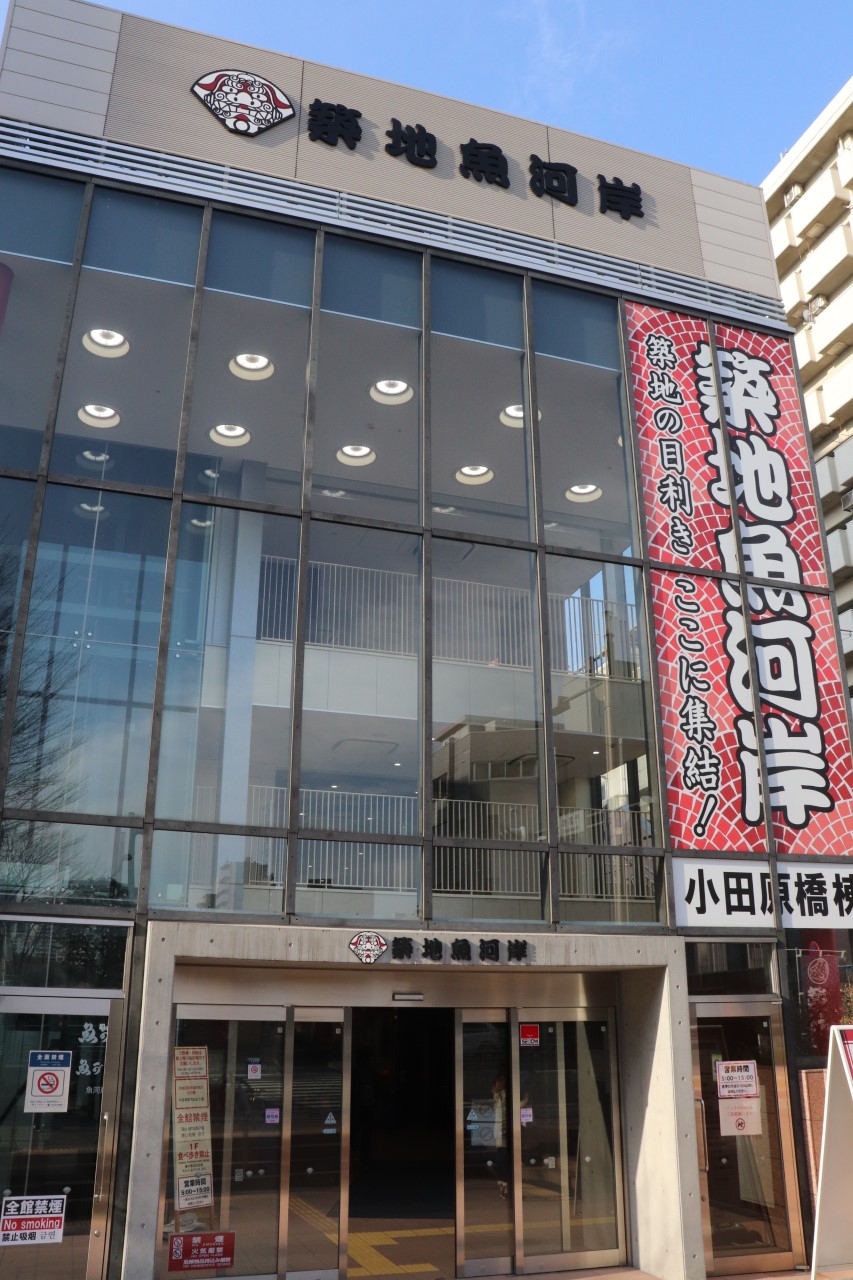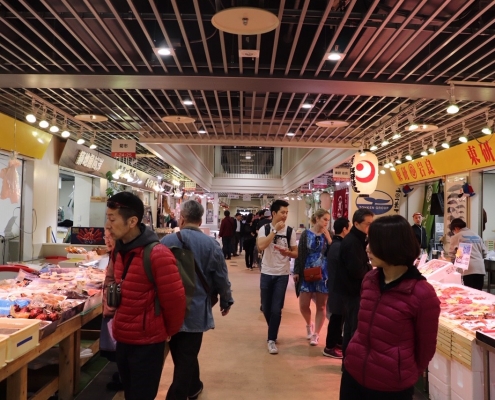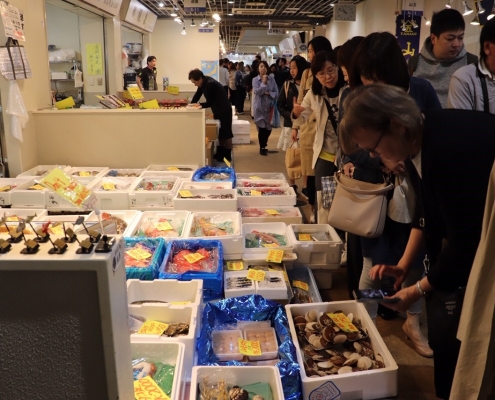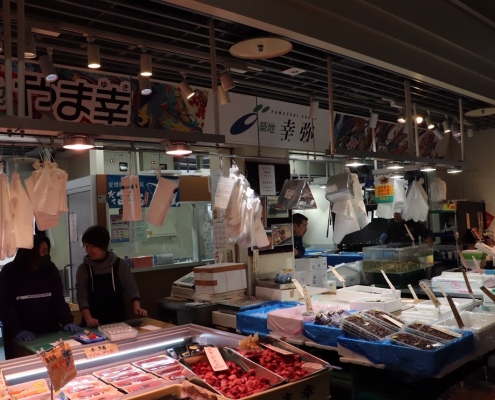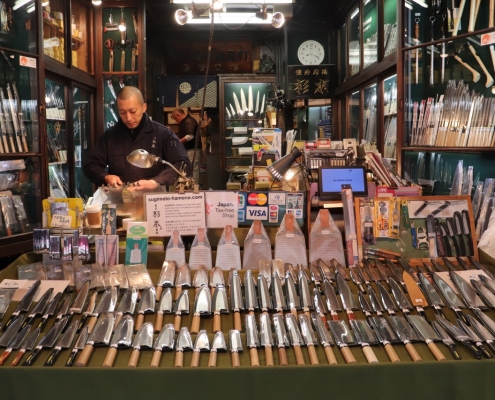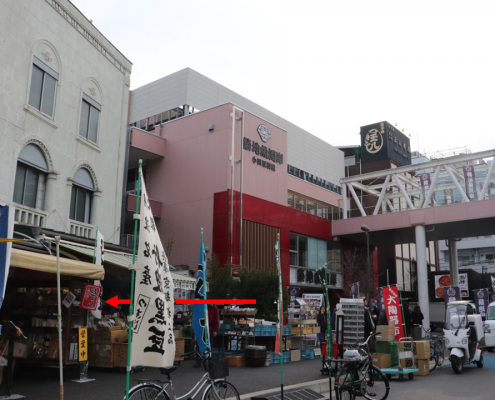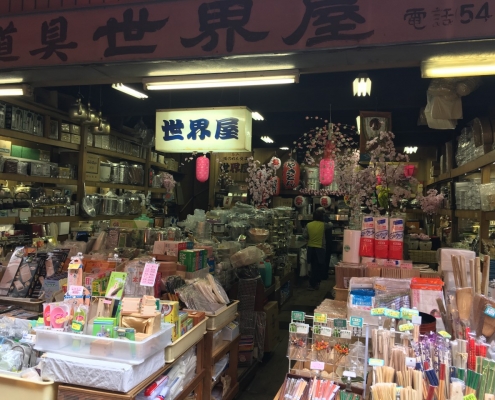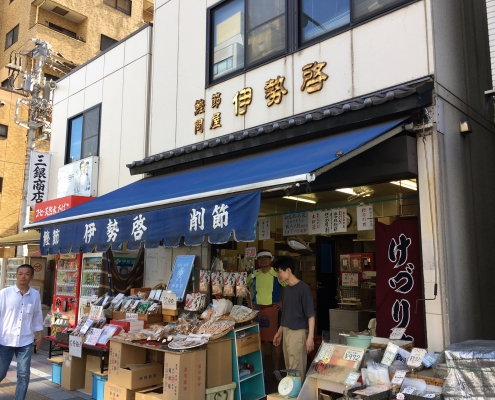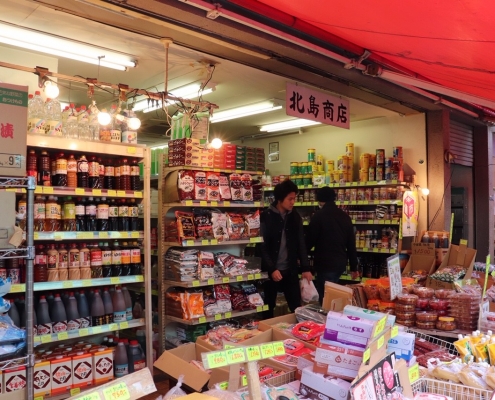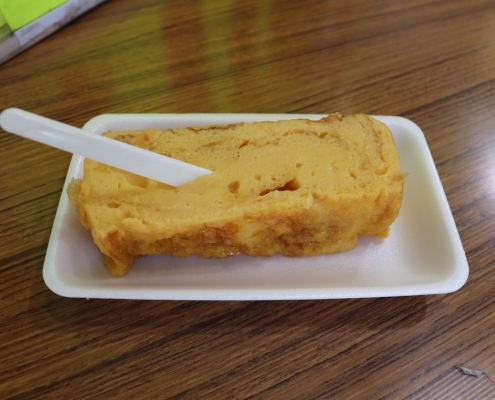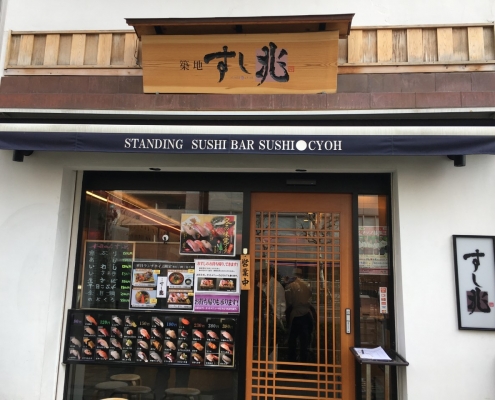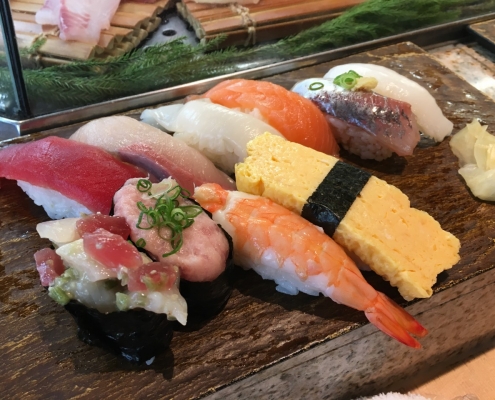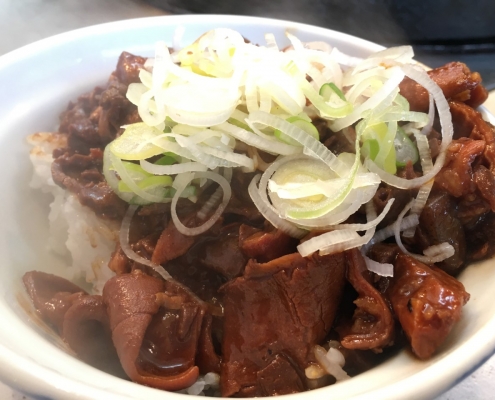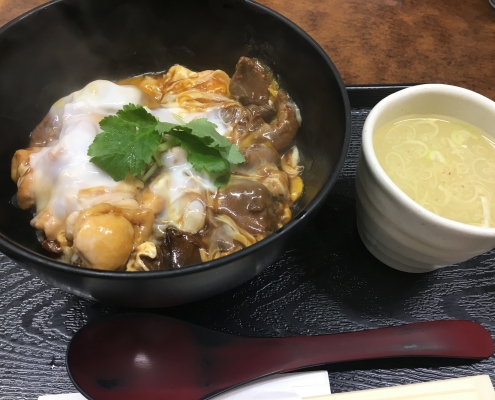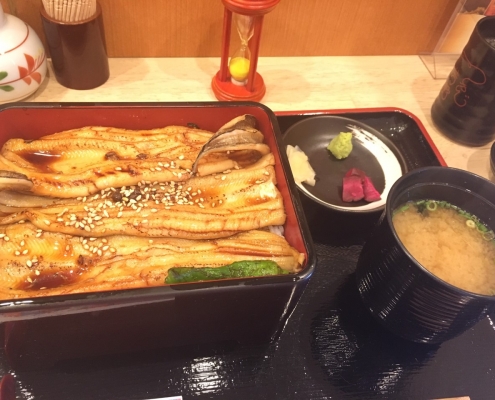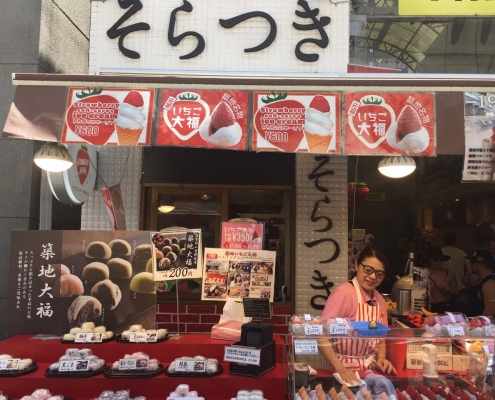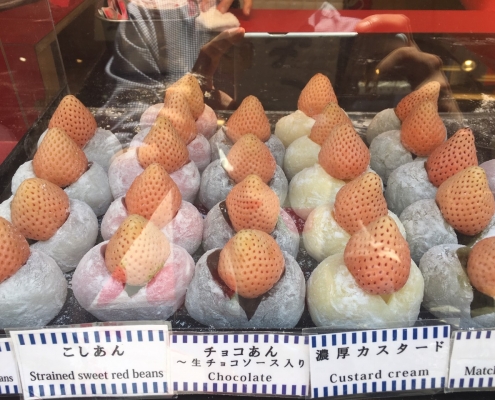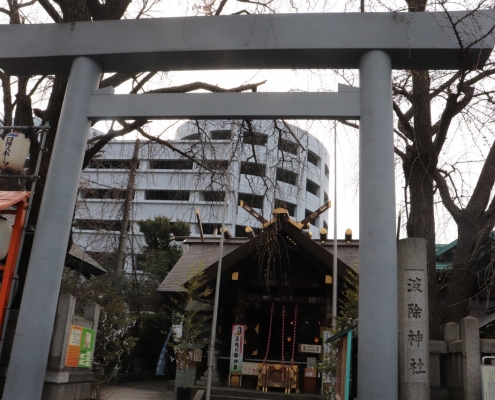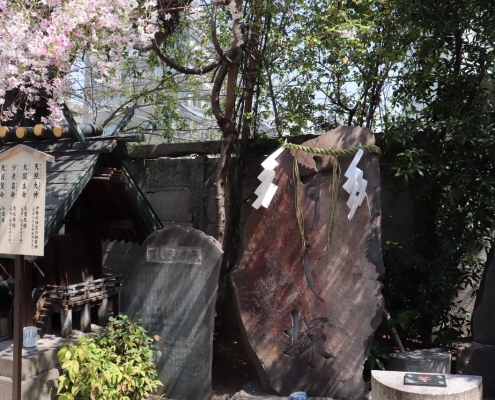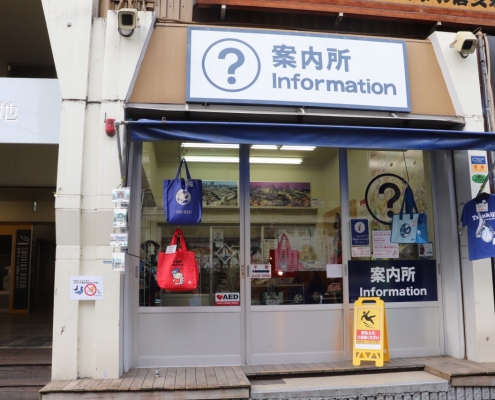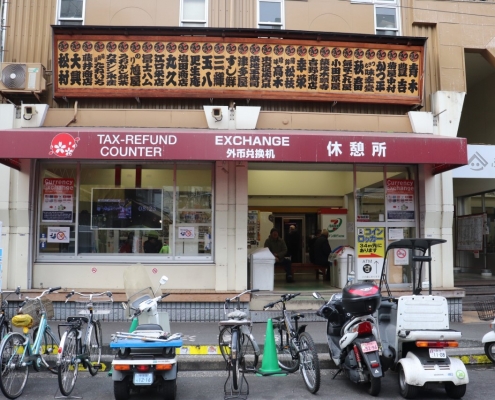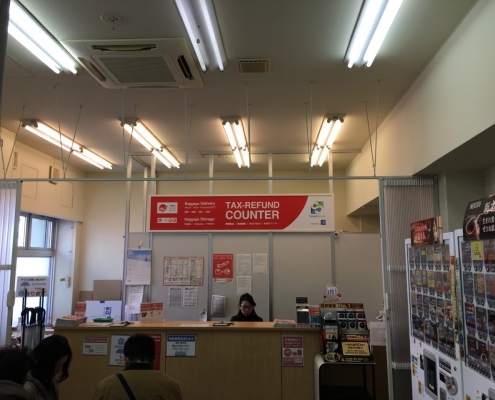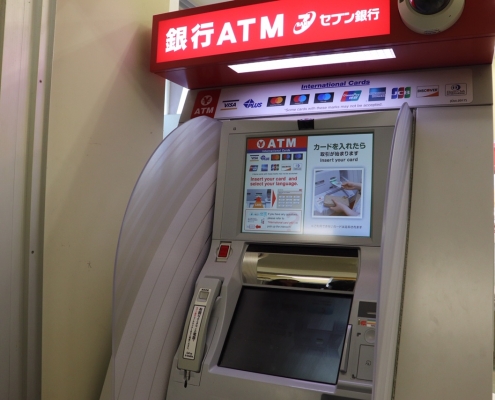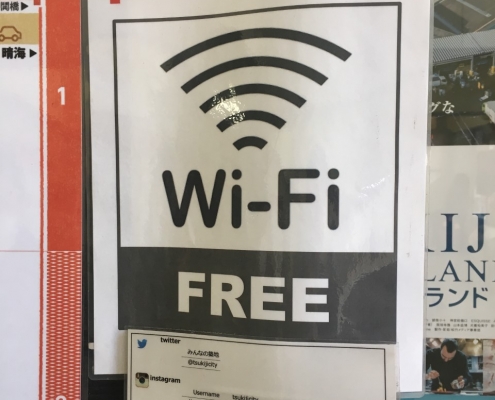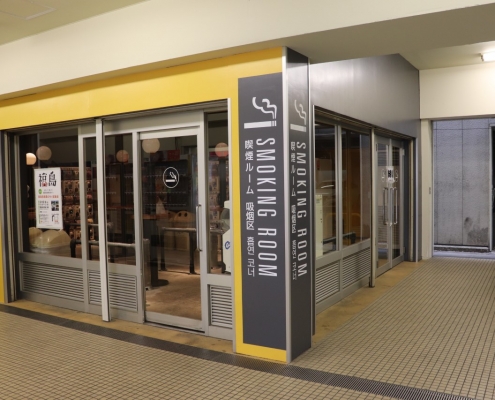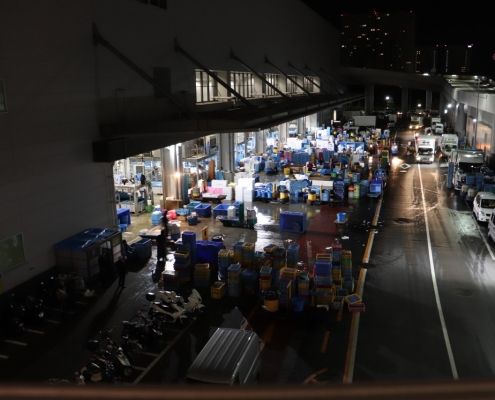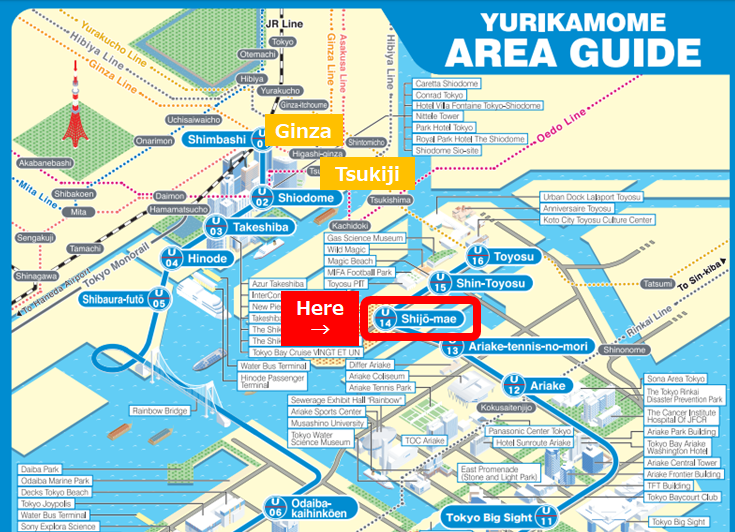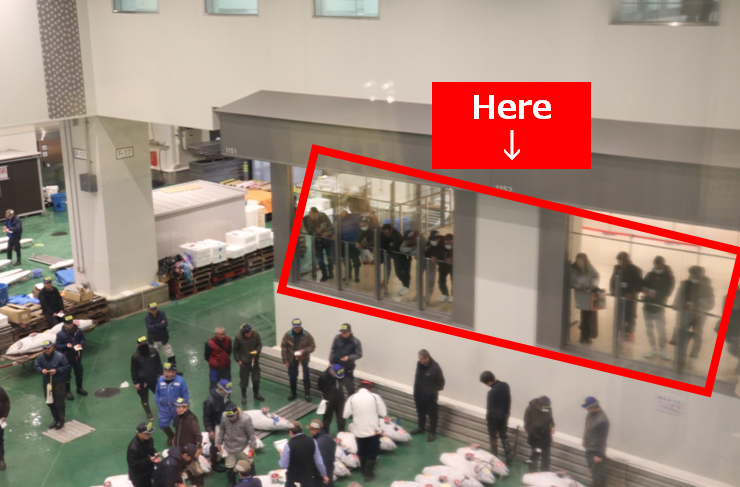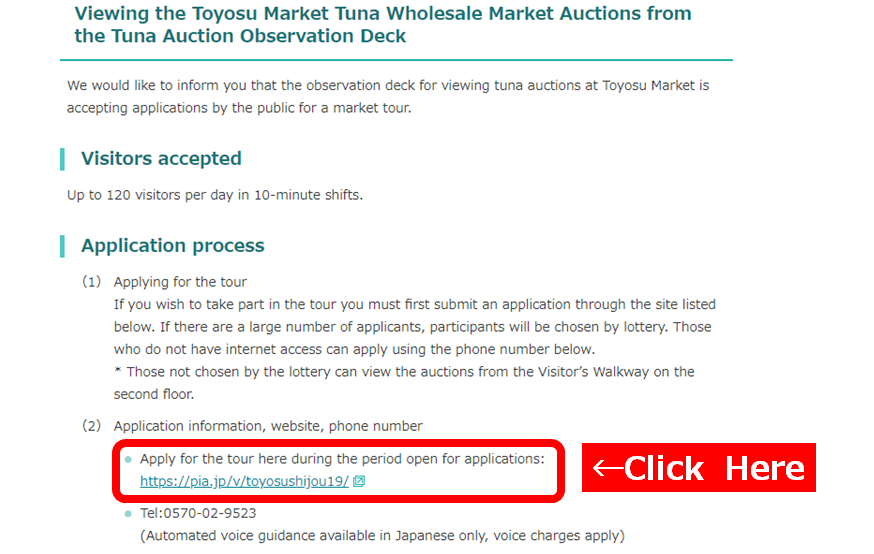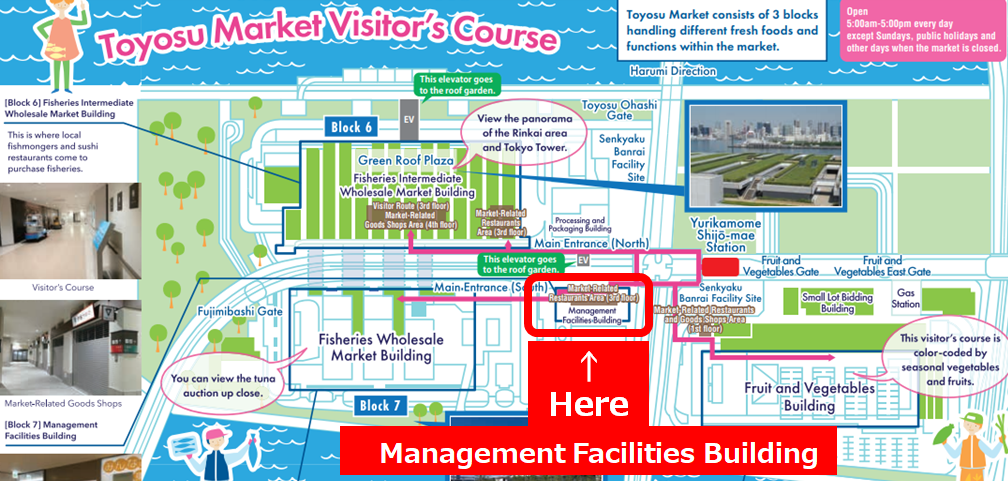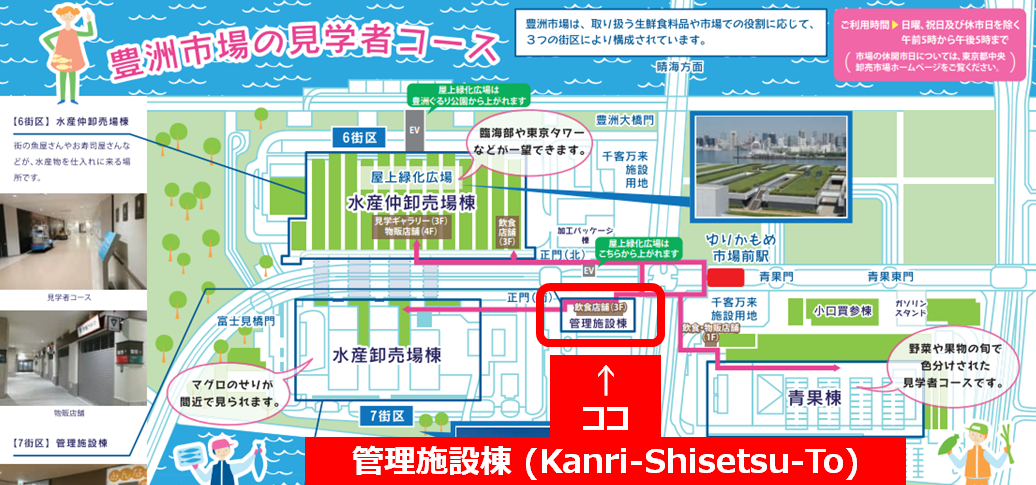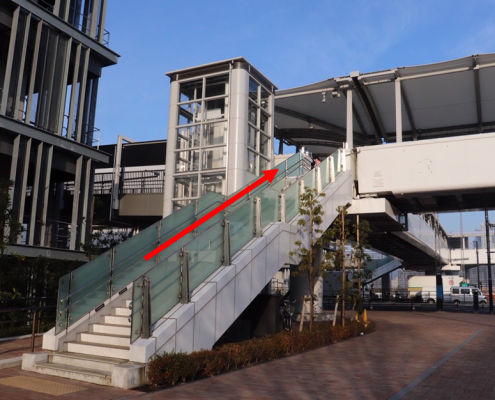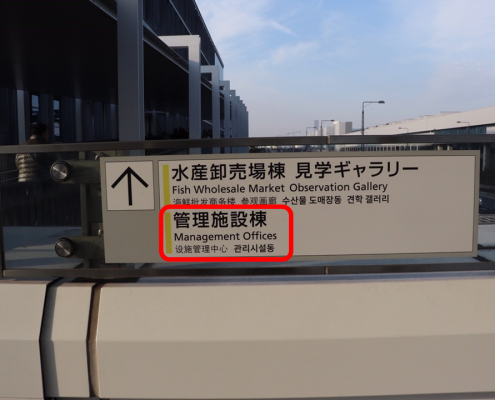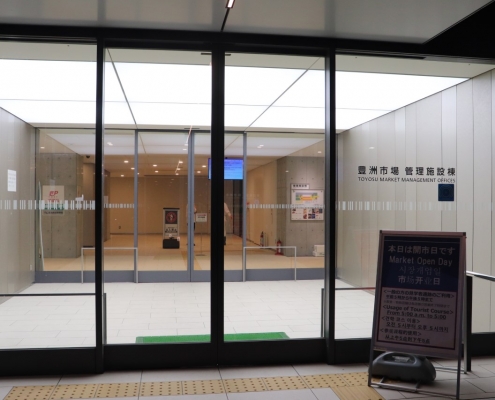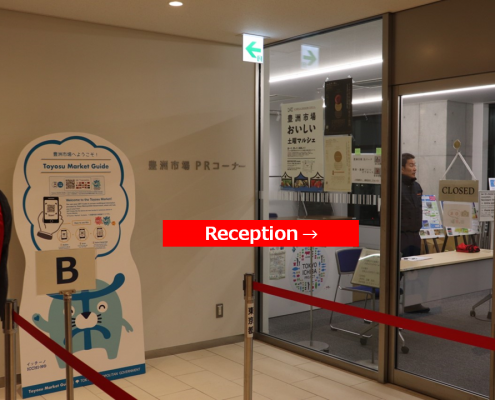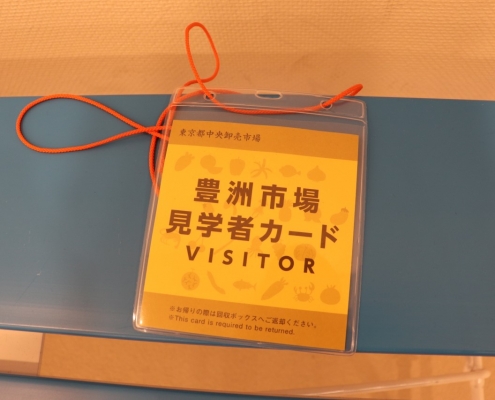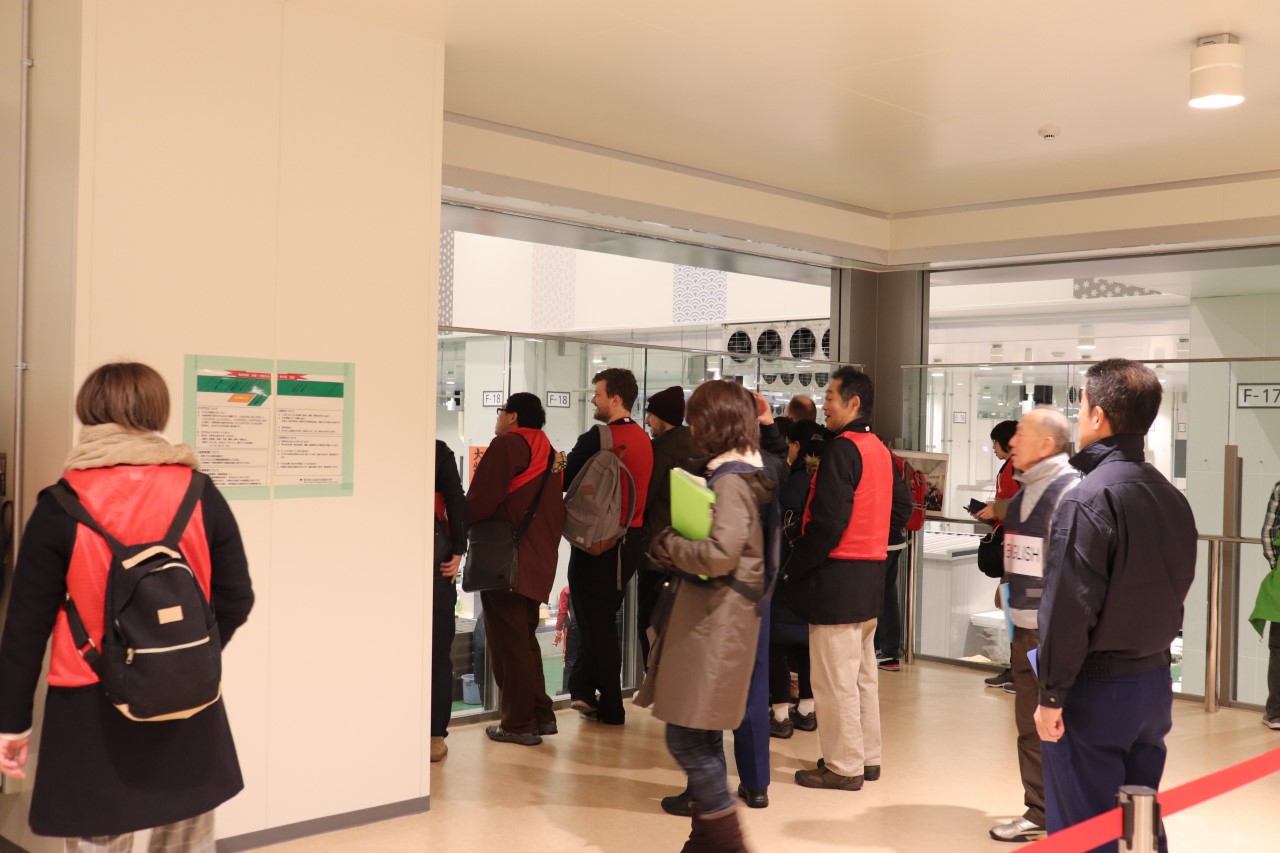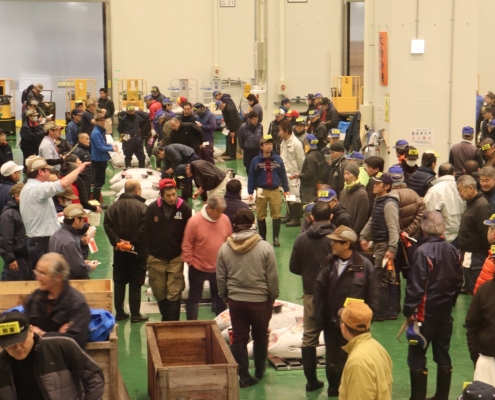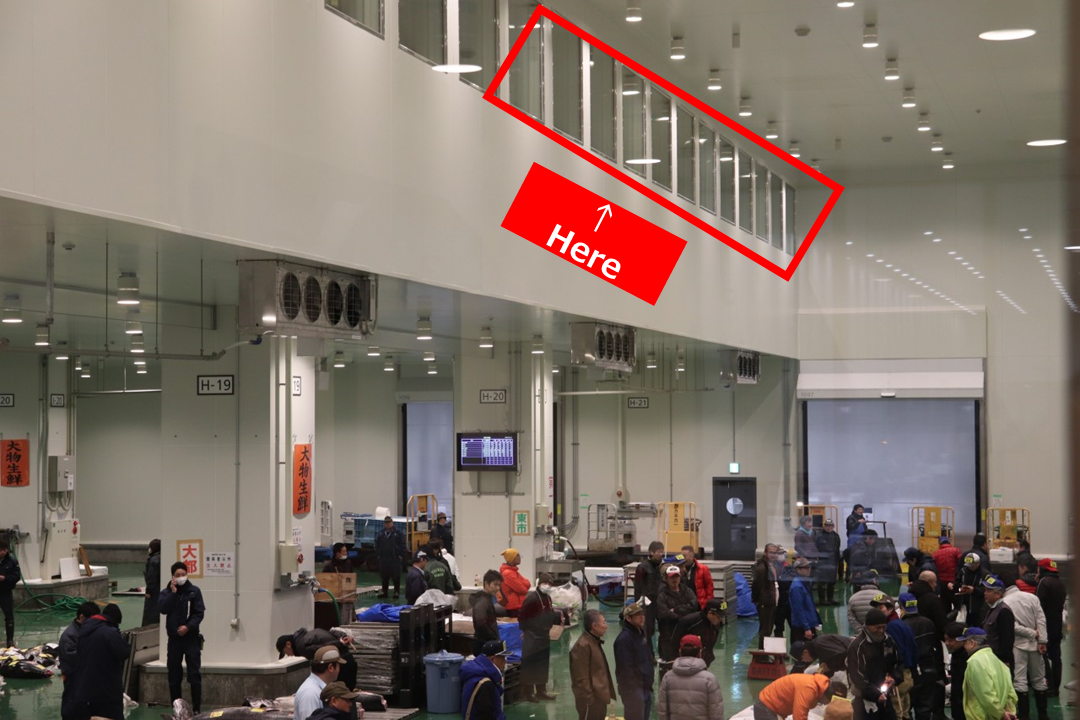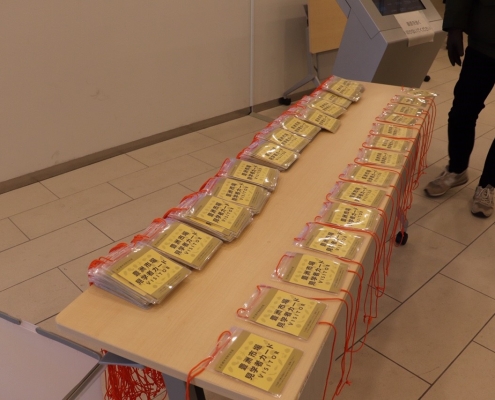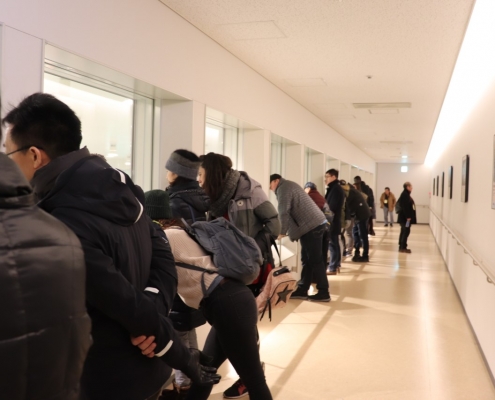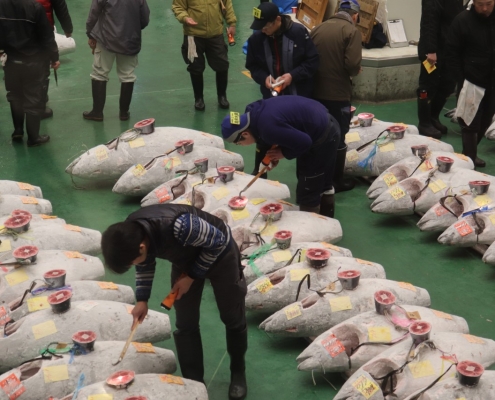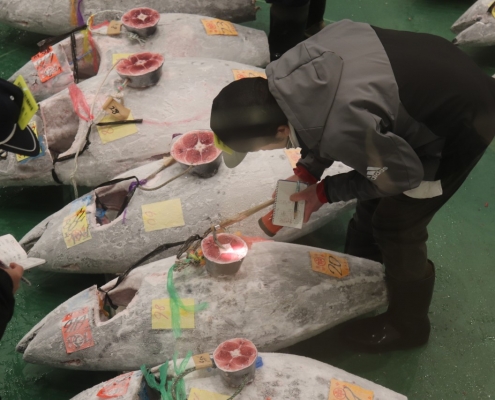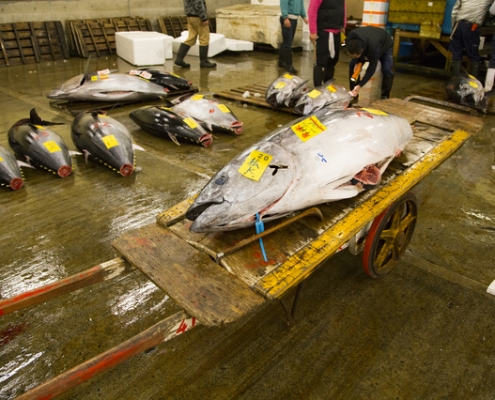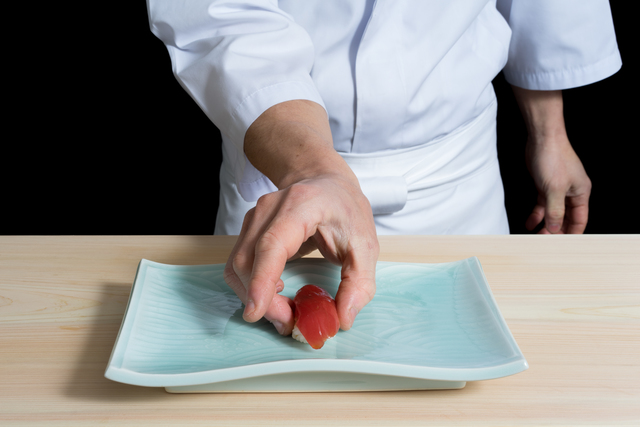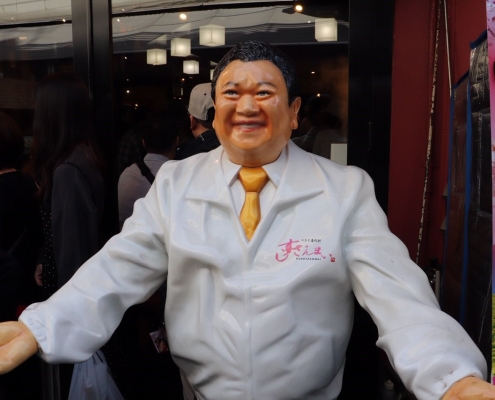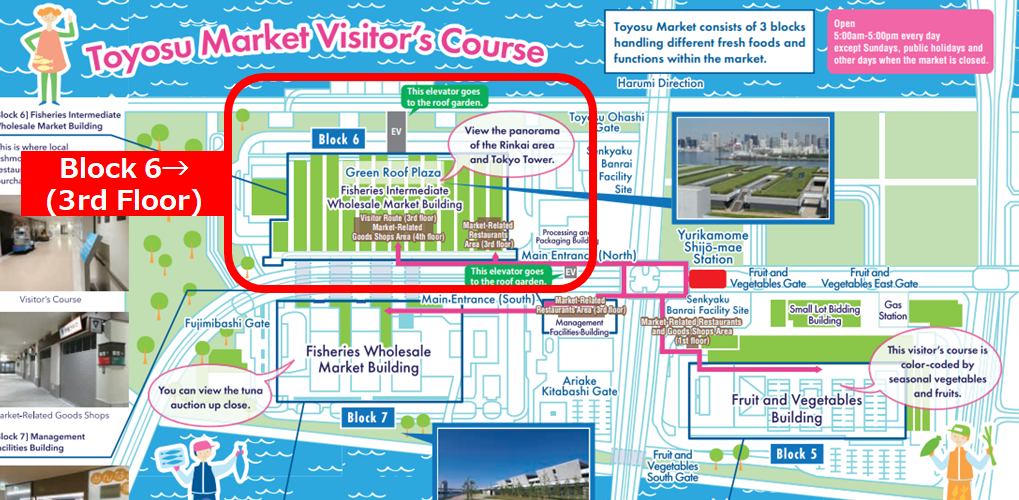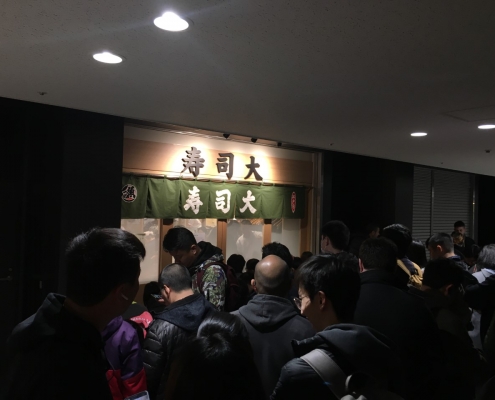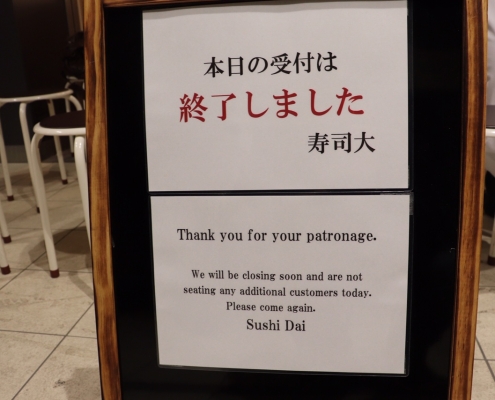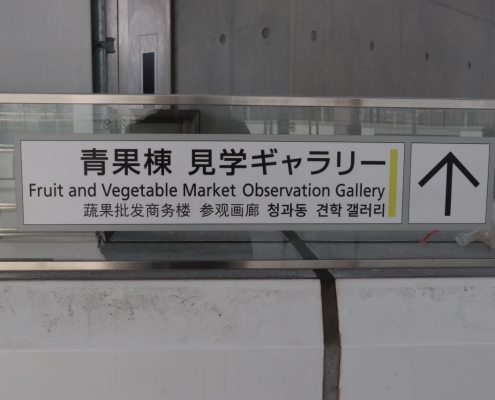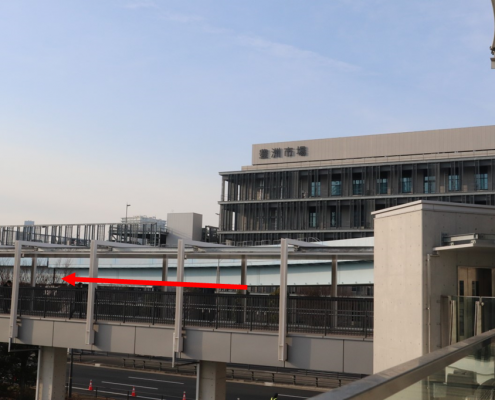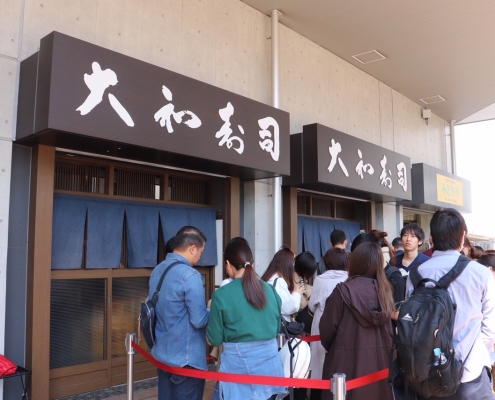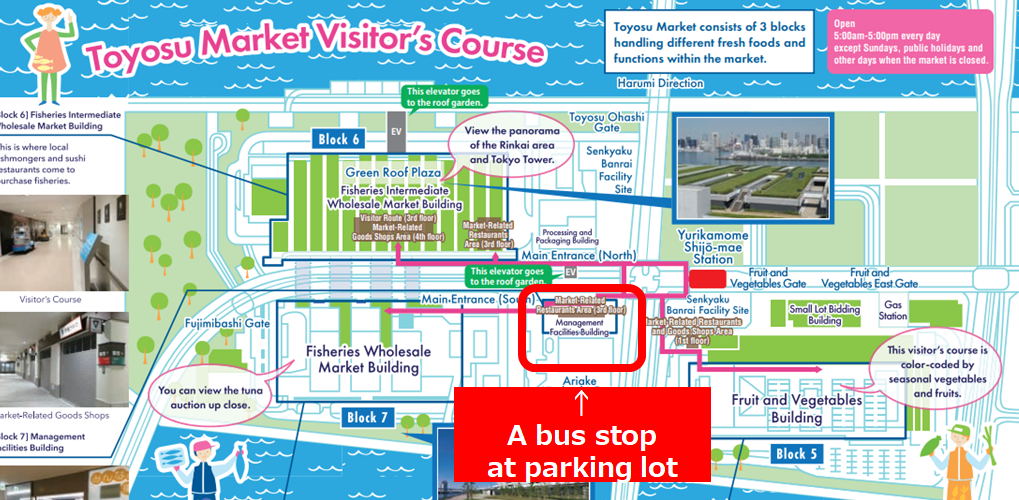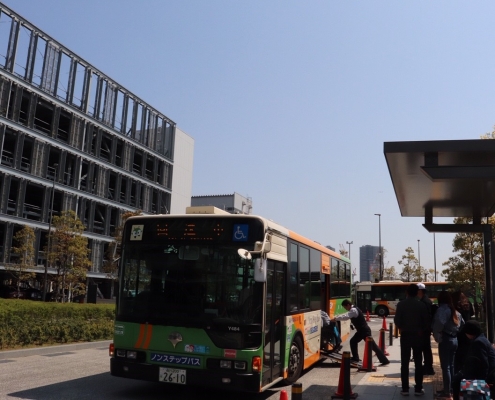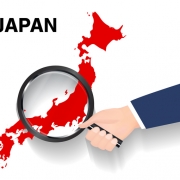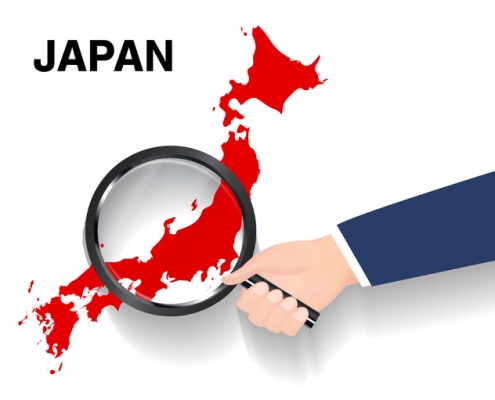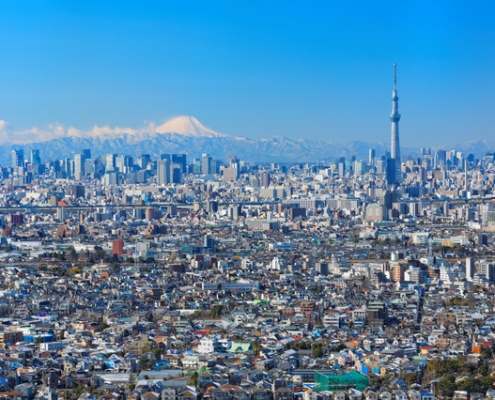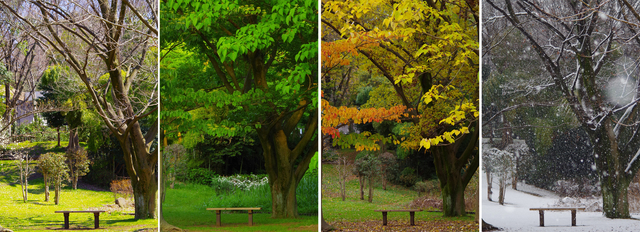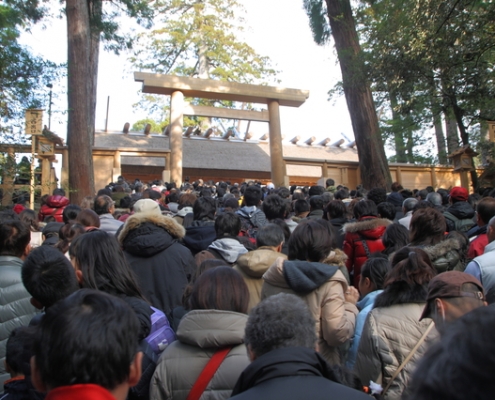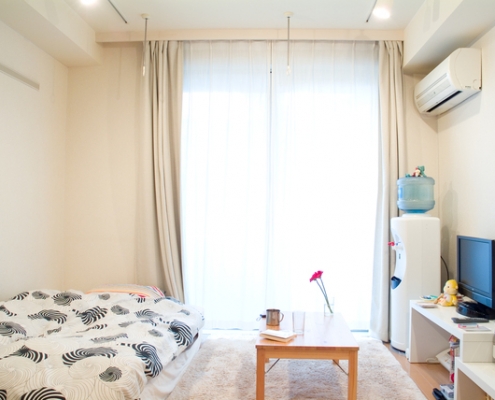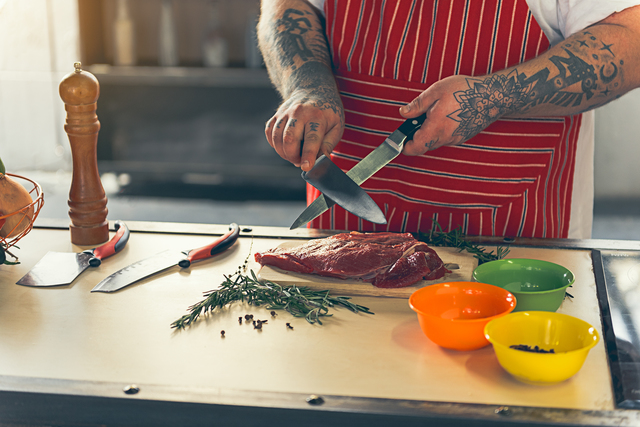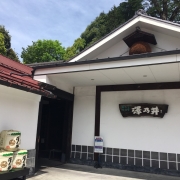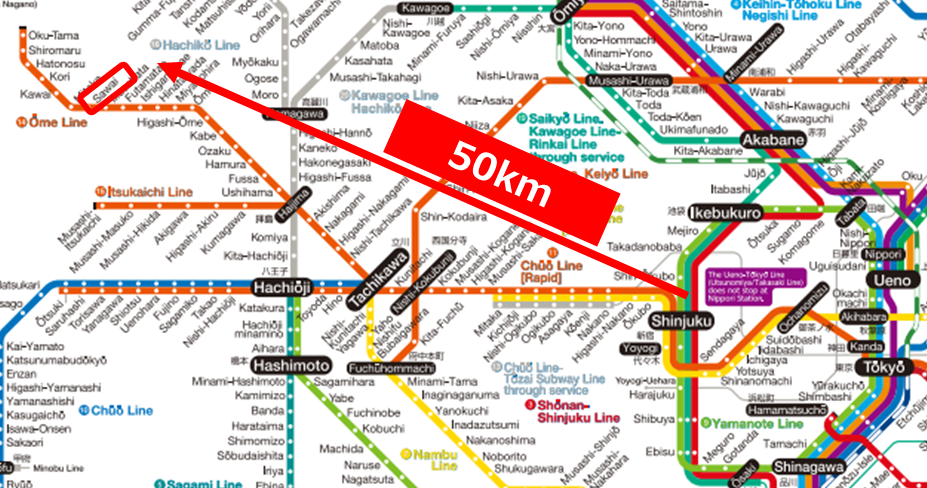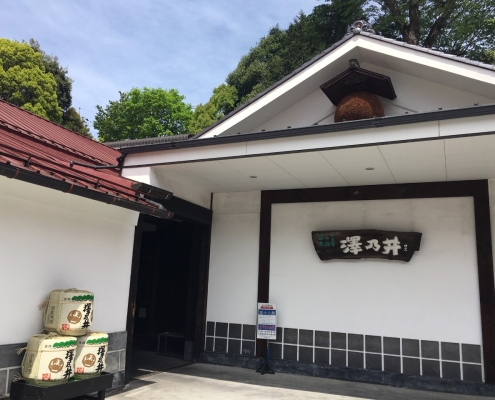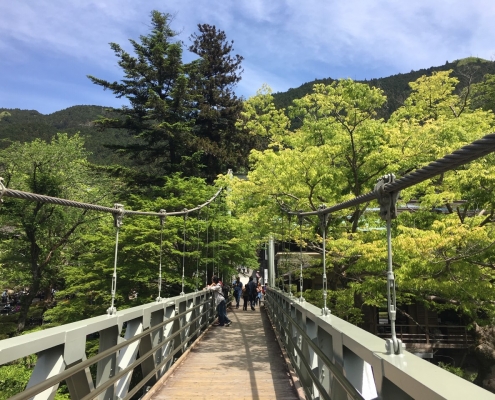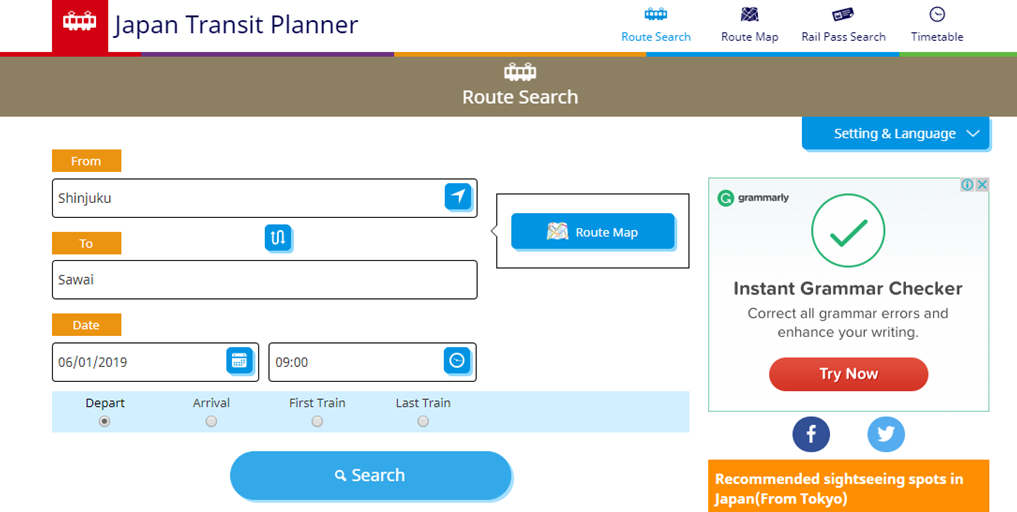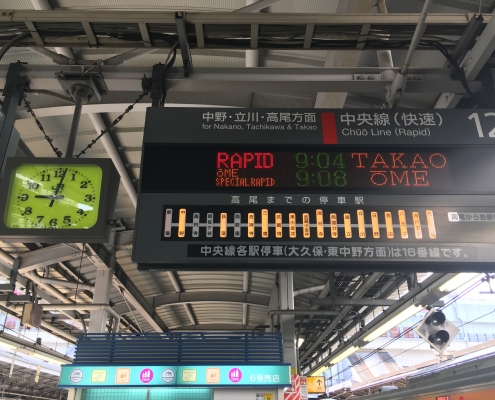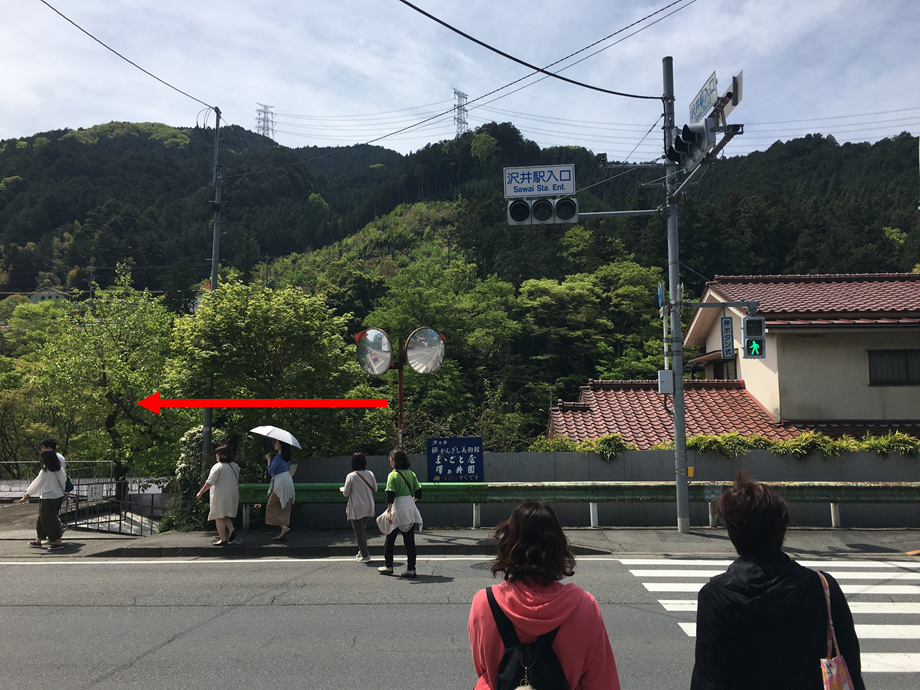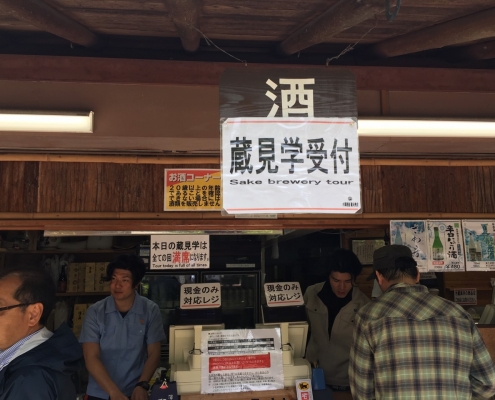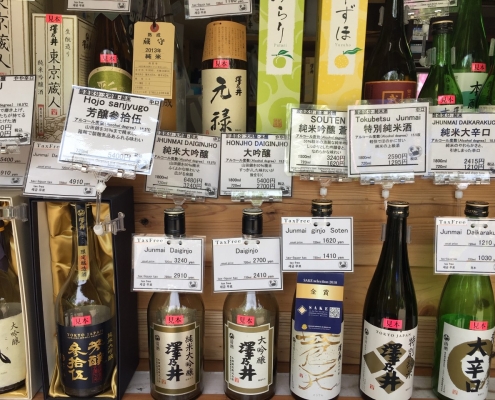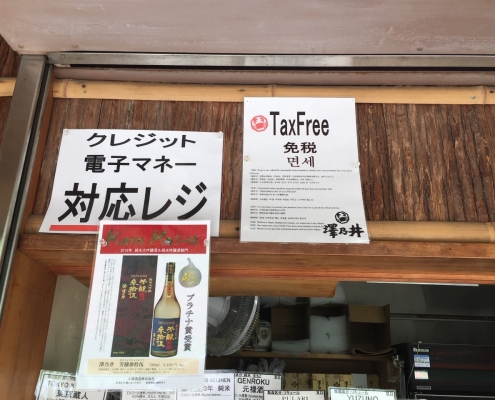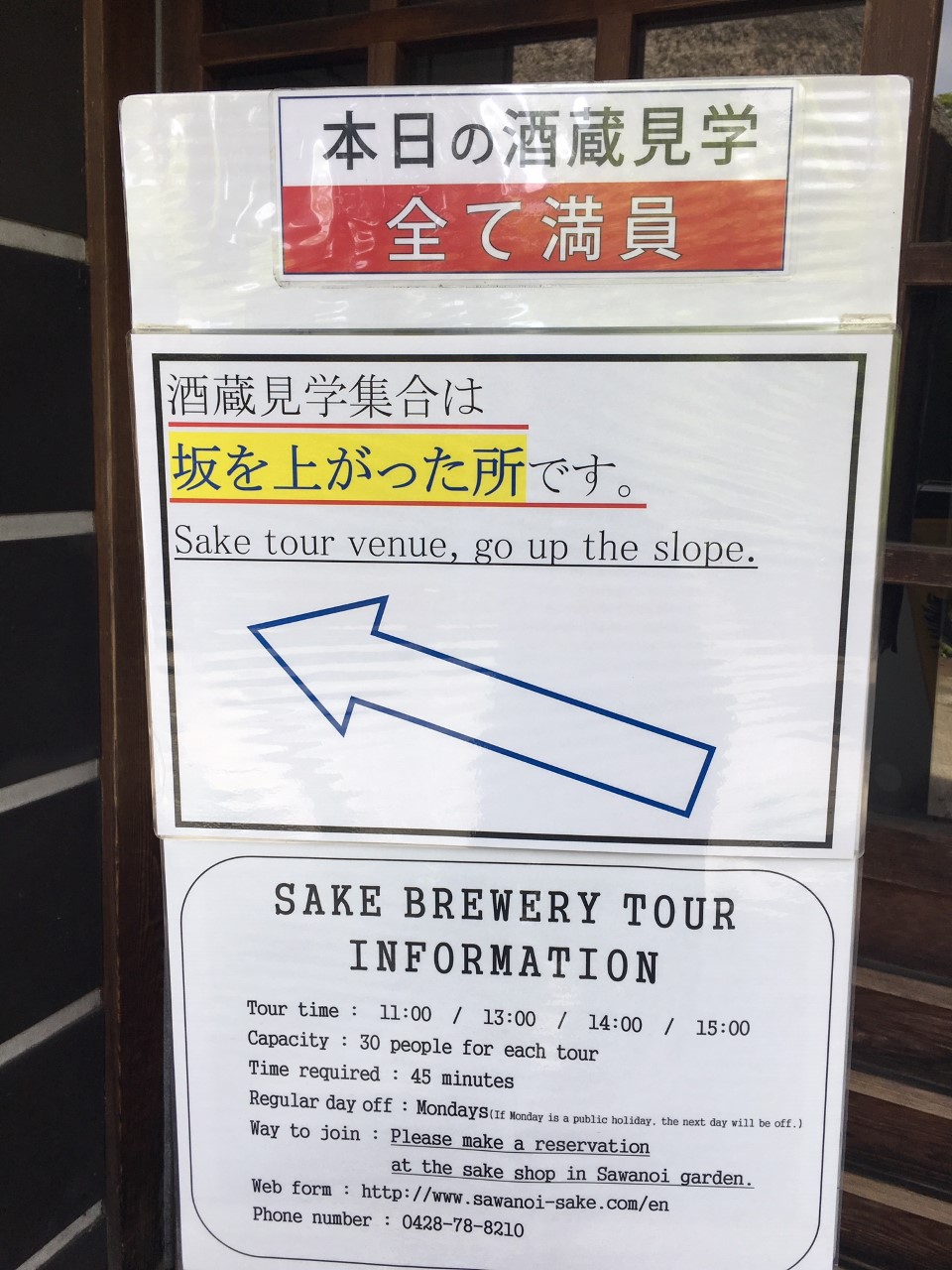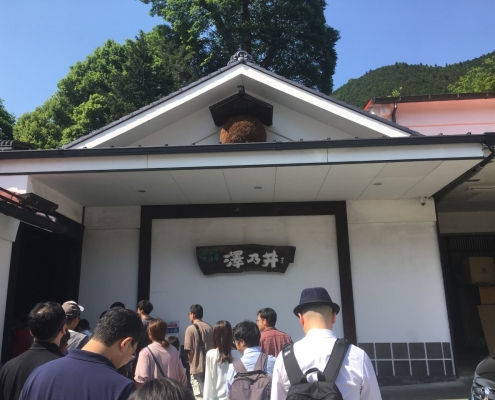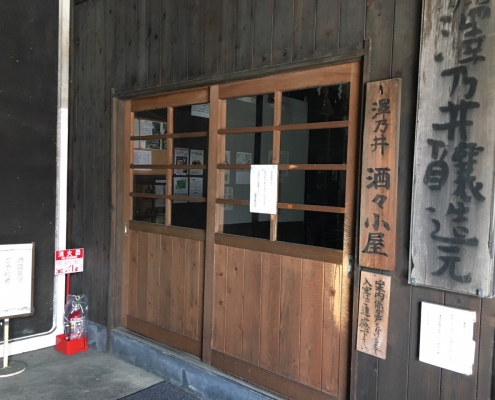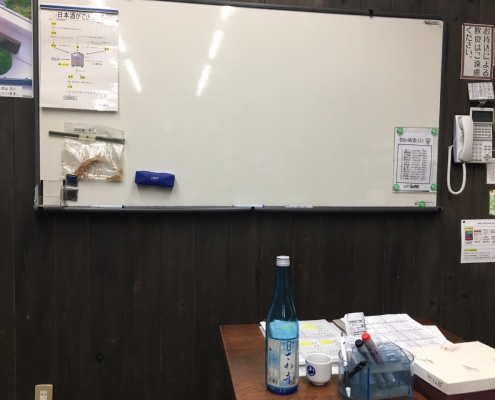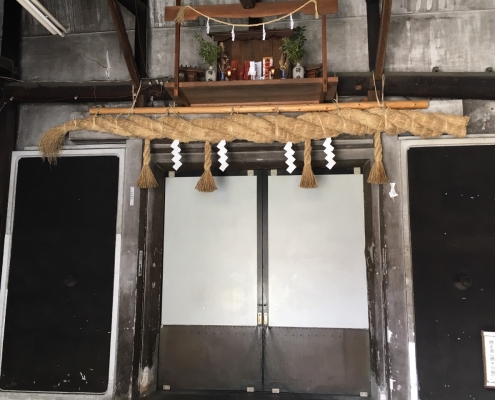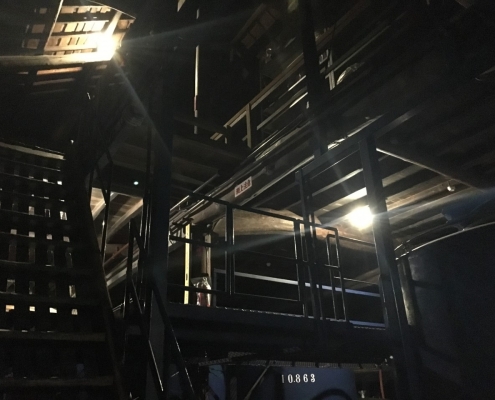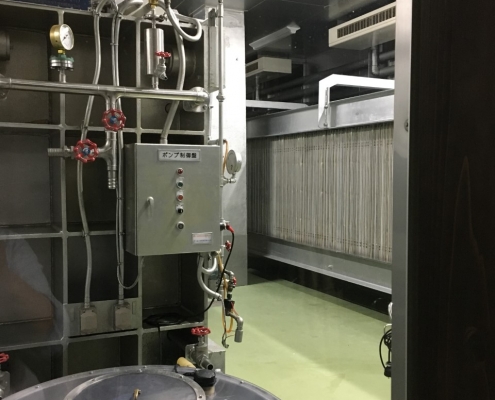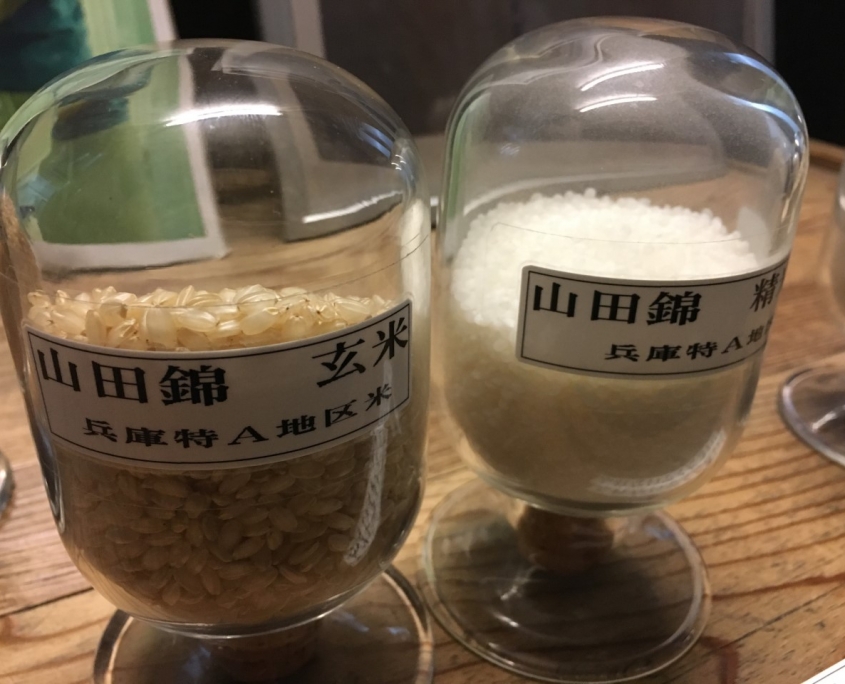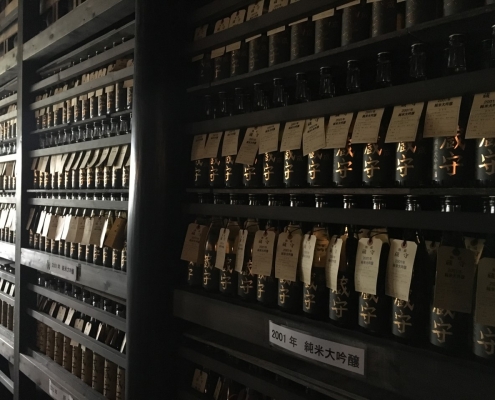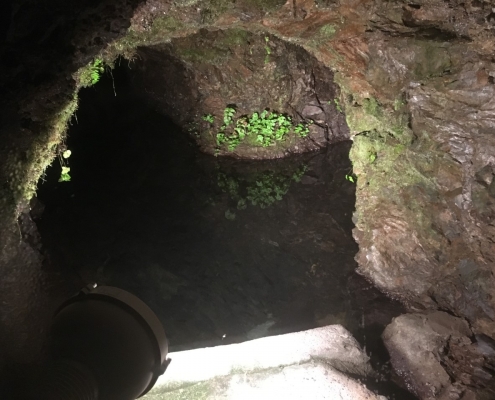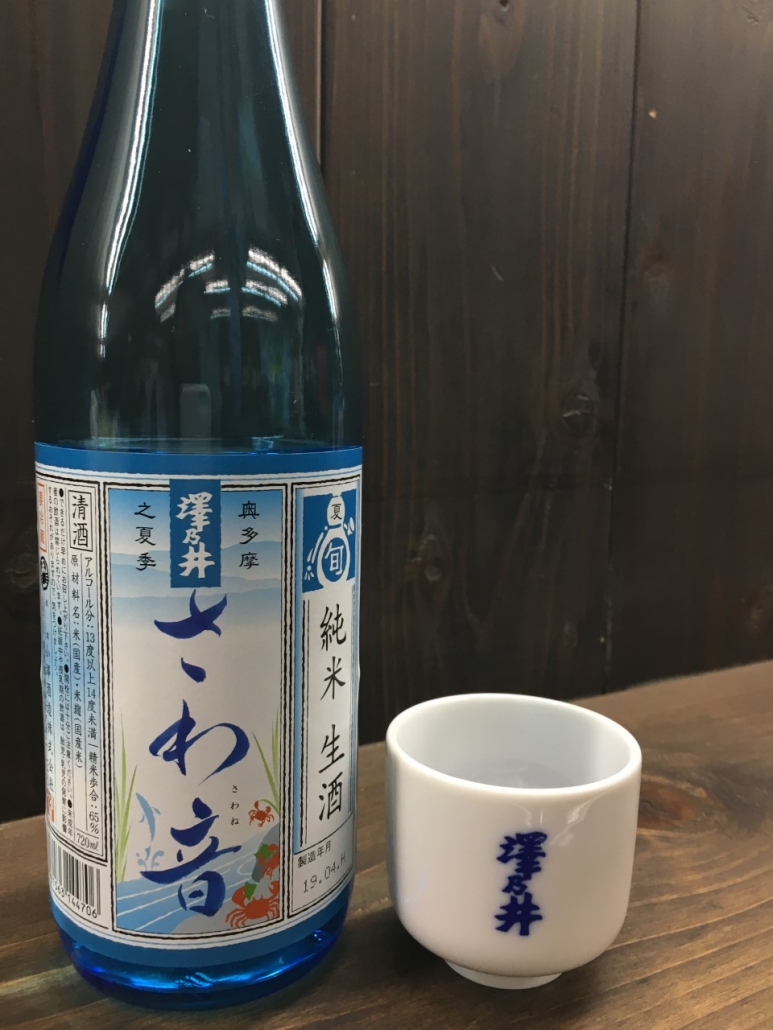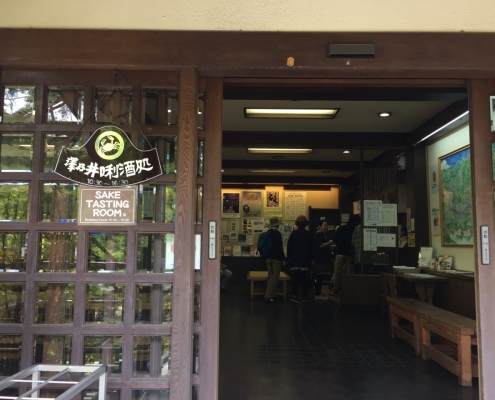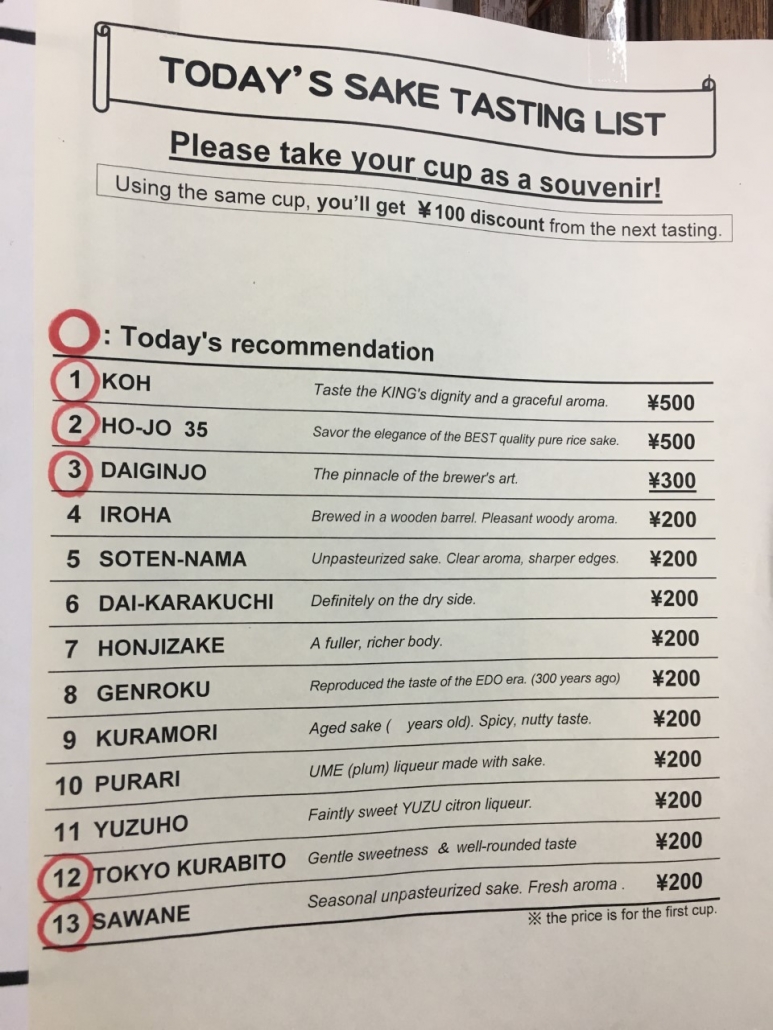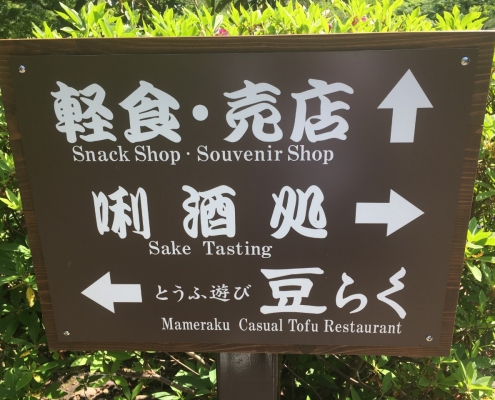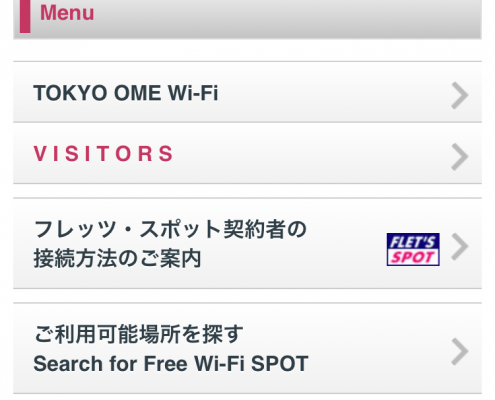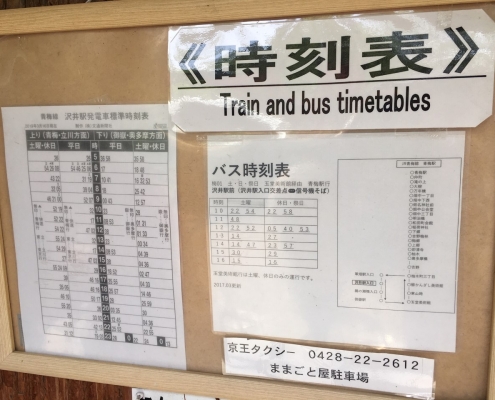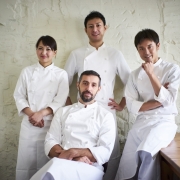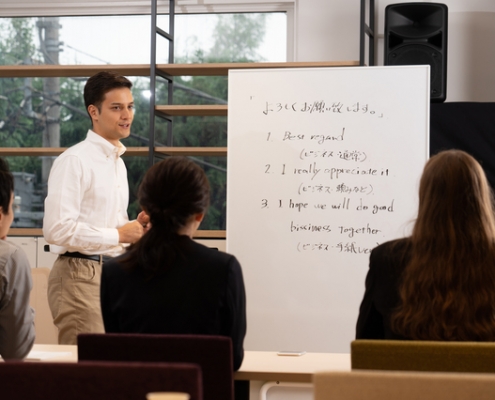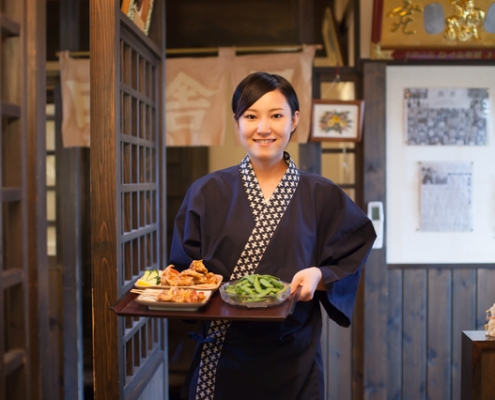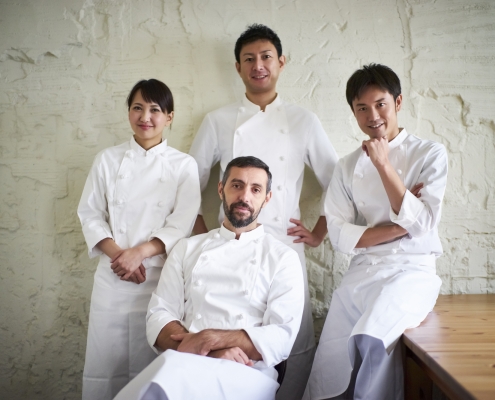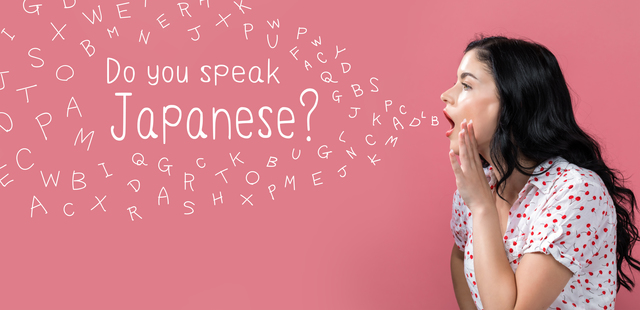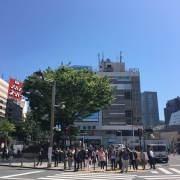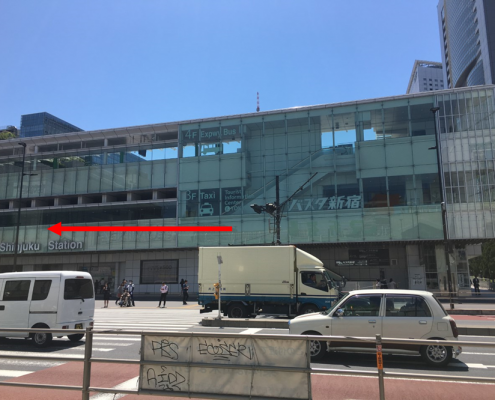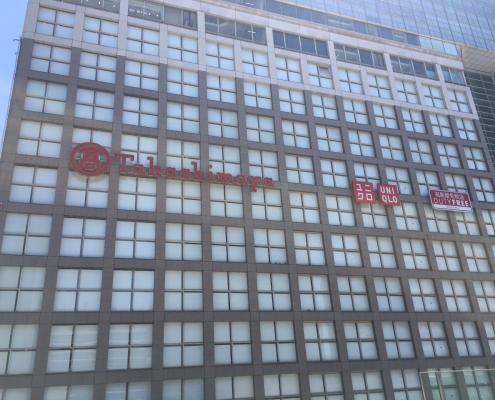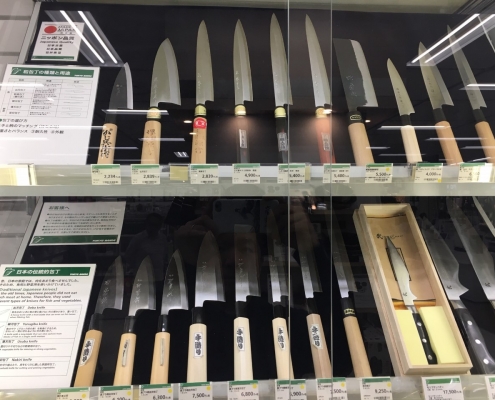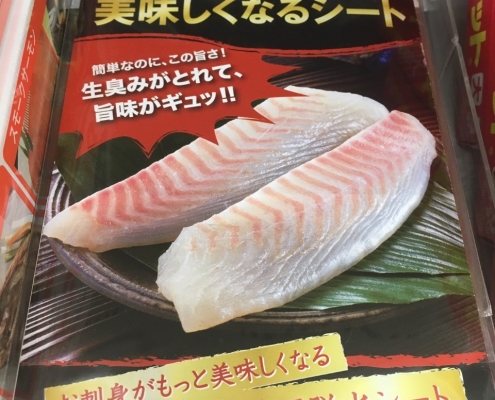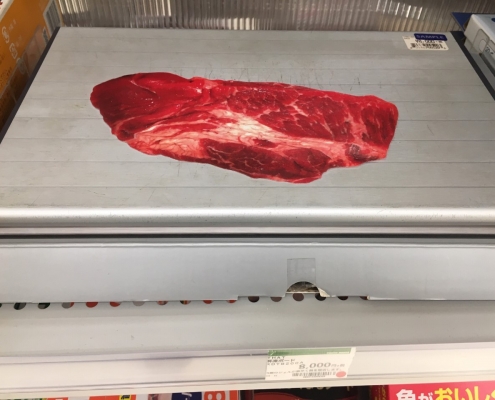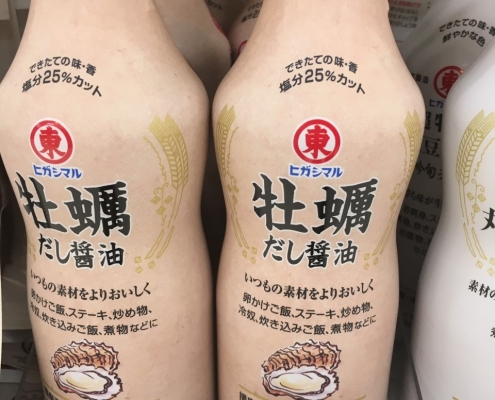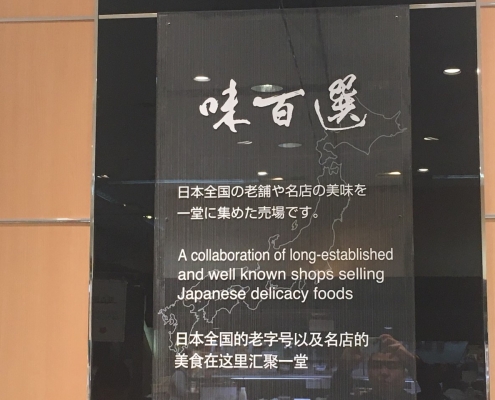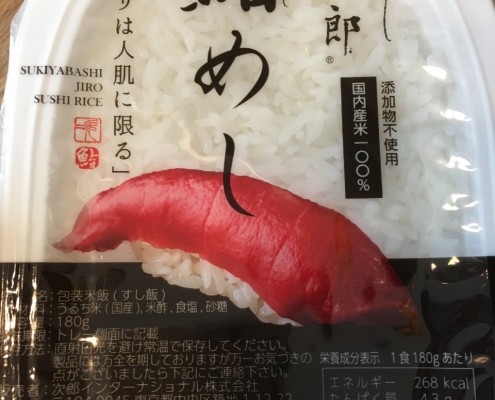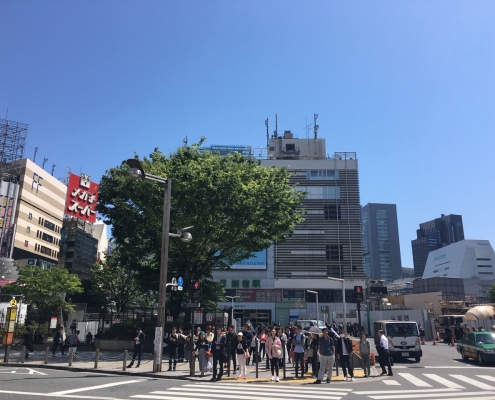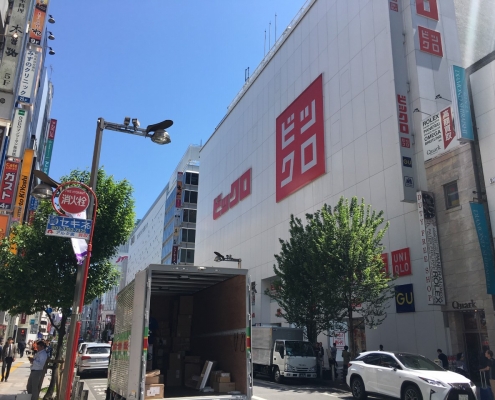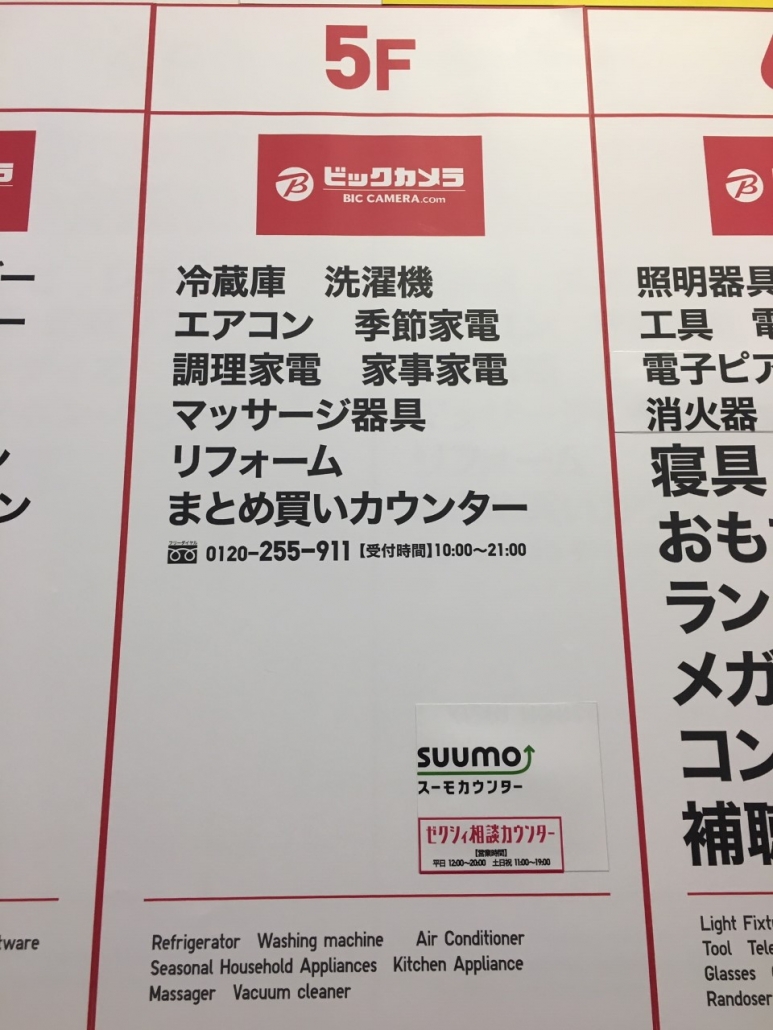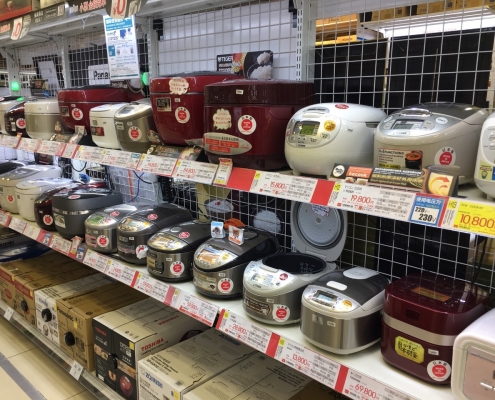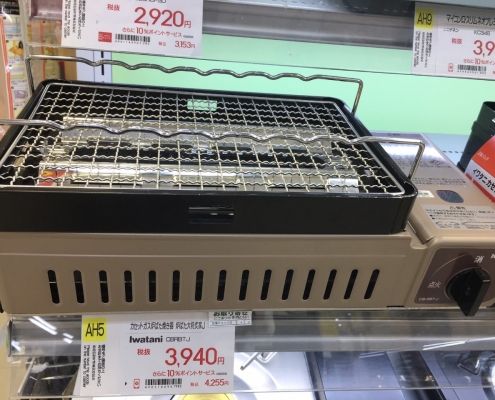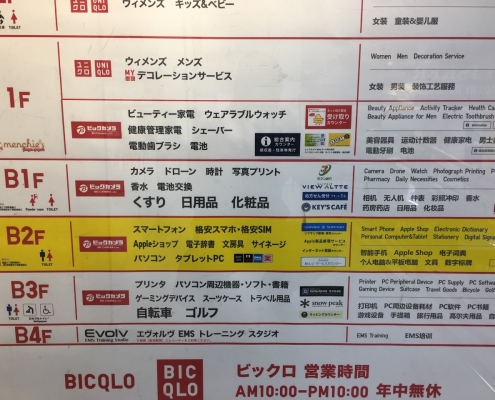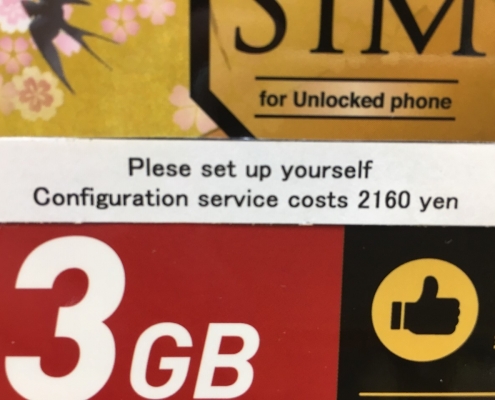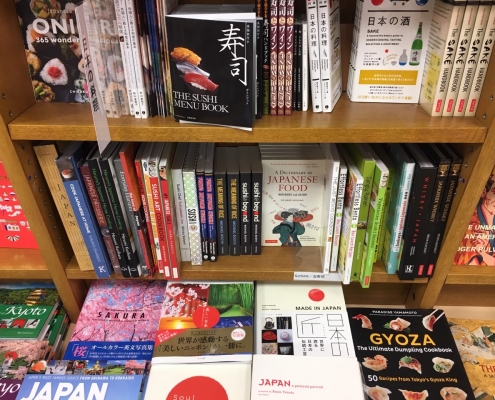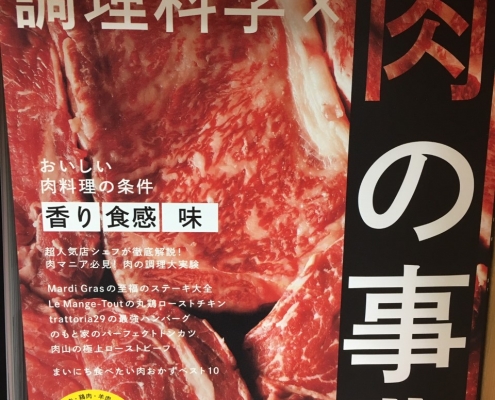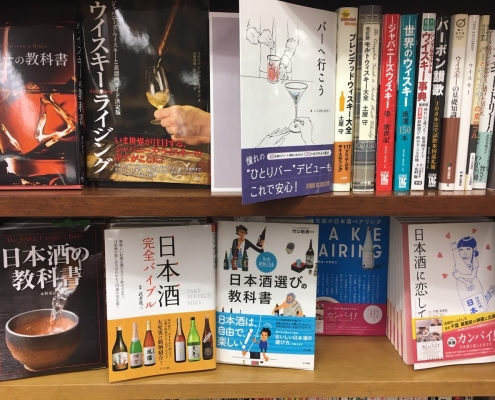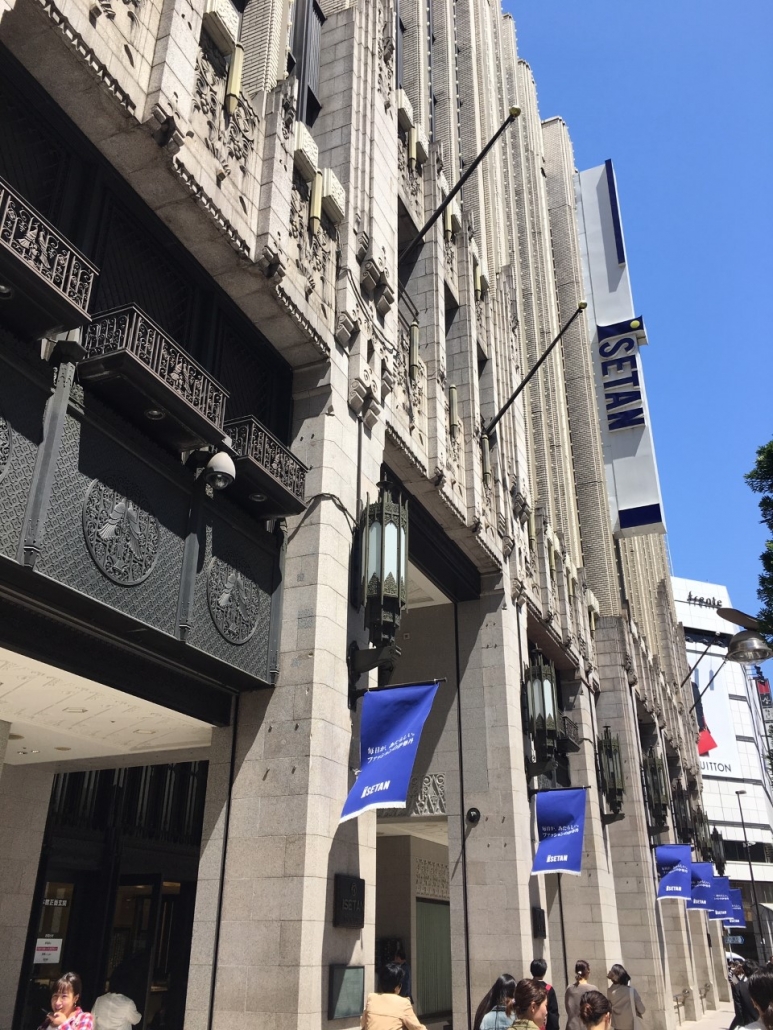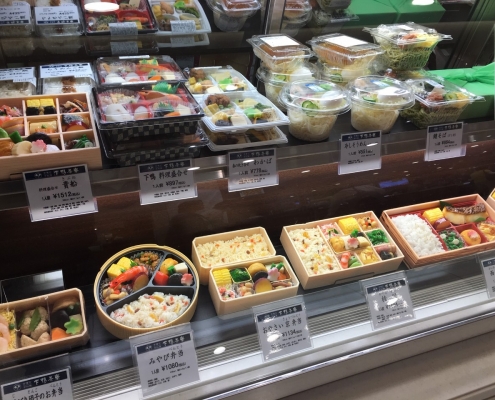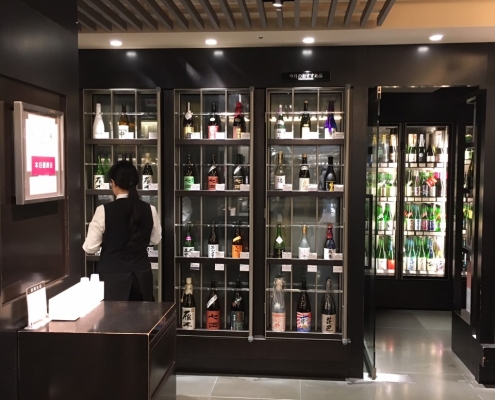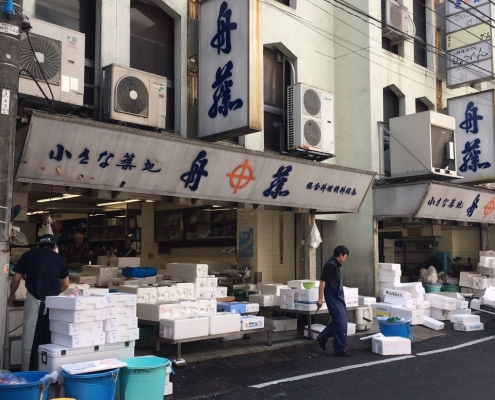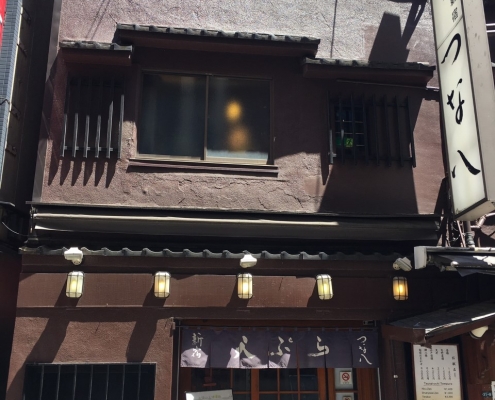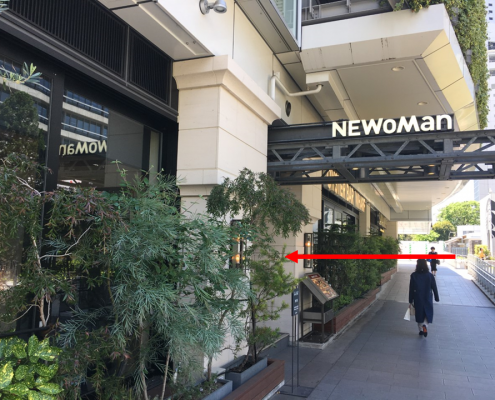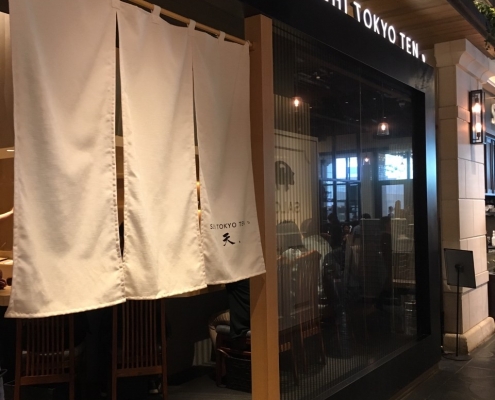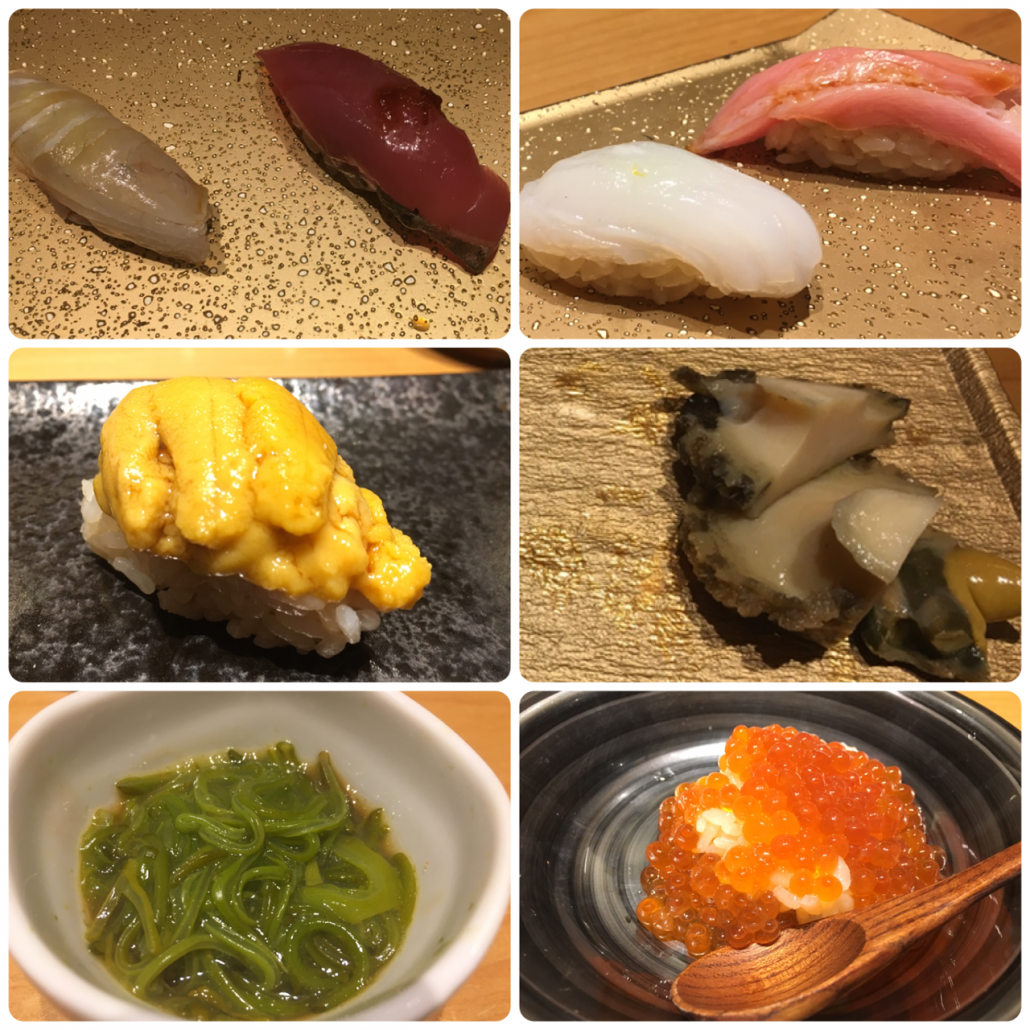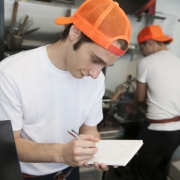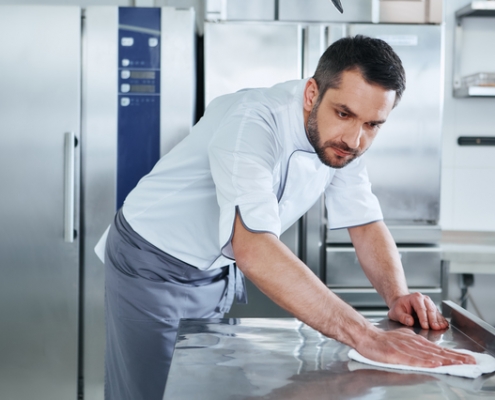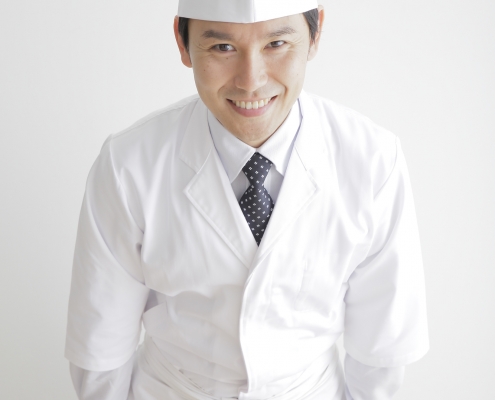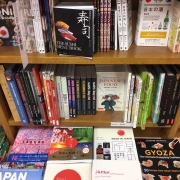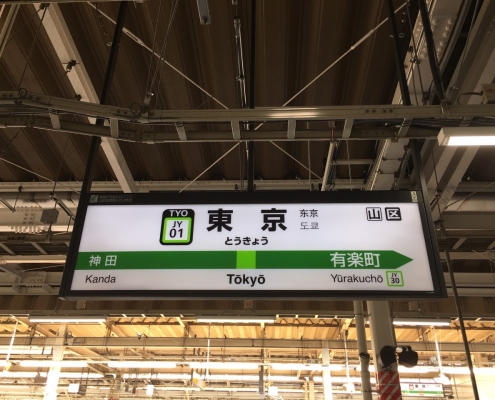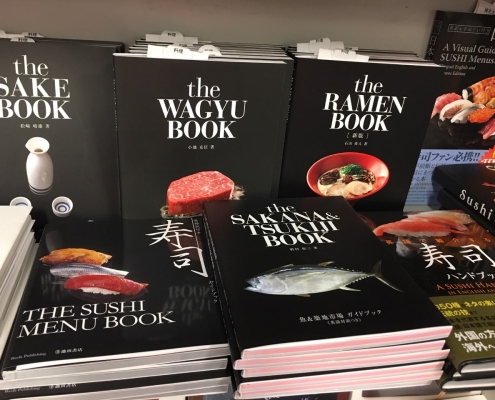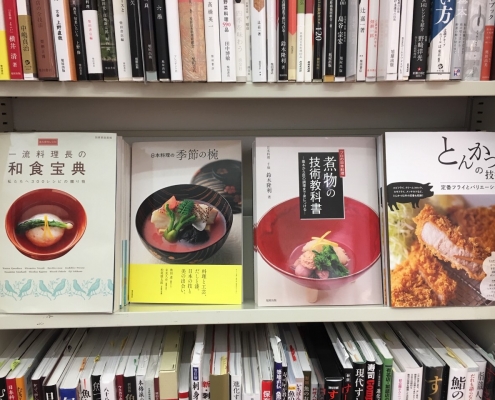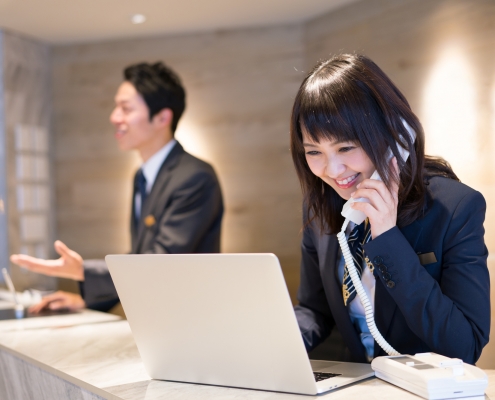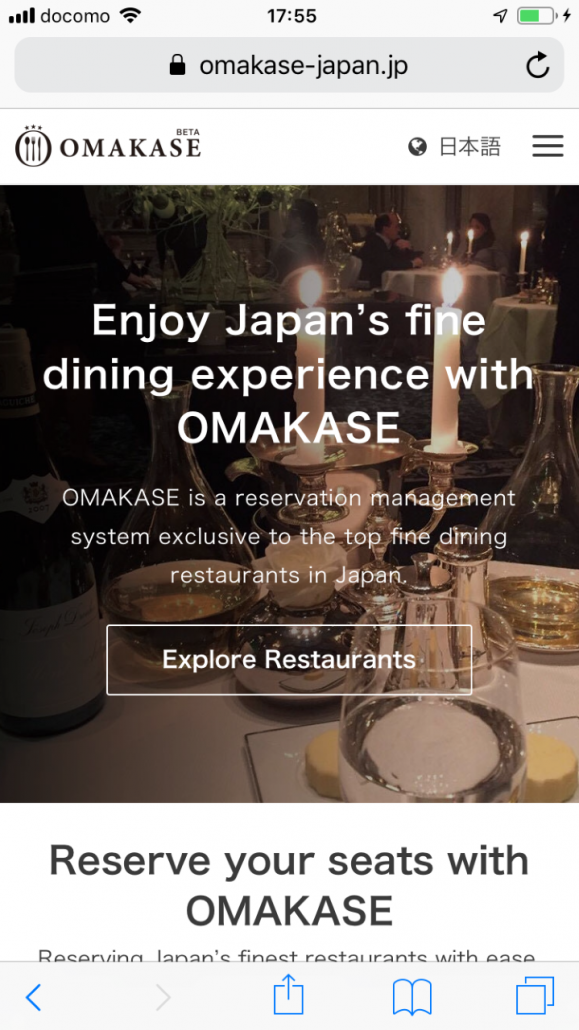Tsukiji
Tsukiji market
Outline
Tsukiji, located at the center of Tokyo, had a world-class market both in terms of quality and quantity.
It gathered seafood from the globe until October, 2018. Watching seafood, treasure for chefs, transported every day, René Redzepi of Noma in Copenhagen said, “If you are an archaeologist you go to the pyramids. If you are a cook you need to visit Tsukiji fish market” in a documentary film, Tsukiji Wonderland.
Due to the aging facilities of the market, most of the wholesalers and intermediate wholesalers moved to the Toyosu market about 3km away in October, 2018. Some people may think all of the Tsukiji market was transferred to Toyosu, but that is not the case. There are still 118 seafood retailers in Tsukiji and run their business for general customers and restaurants.
Besides 118 seafood retailers, there are 17 kombu (kelp) and niboshi (dried baby sardines) stores, 15 nori (dried seaweed) and tea stores, 10 bonito flake stores, 9 kitchen knife stores and 9 tamagoyaki (Japanese egg omelet) stores. Tsukiji still attracts foodies and chefs from the world with its prominent food culture.
The Inner and Outer markets
場内(Jonai) / 場外(Jogai) 市場 (Market)
The Inner market (“Jonai”) is where wholesalers and intermediate wholesalers used to run business and the Outer market (“Jogai”)is where retailers sold their goods. As the wholesalers and intermediate wholesalers moved from the Inner market to Toyosu, local people call what is left in Tsukiji the Outer market (“Jogai Shijo”).
The Inner market (“Jonai”) is closed on Oct. 2018
The Outer market (“Jogai”) still attracts foodies from all over the world
Business Hours
Business hours varies by shop, usually they open from early morning to 14:00 or 15:00 (Better to visit in Tsukiji in morning time!) and
many of them are closed on Sundays, national holidays and some Wednesdays.
How to get to Tsukiji?
By Train
There are 4 nearest stations to the Tsukiji market. It takes about 1 to 5 minutes from each station on foot.
Tokyo Metro Hibiya Line, Tsukiji Station, Exit 1 or 2
Toei Oedo Line, Tsukiji-shijo Station, Exit A1
Toei Asakusa Line, Higashi-Ginza Station, Exit 5 or 6
Tokyo Metro Yurakucho Line, Shintomicho Station, Exit 4
From the Ginza area
The Ginza area attracts wealthy gourmets and features 42 restaurants which are awarded stars by the Michelin Guide Tokyo 2019. The thriving food culture in Ginza cannot be separated from the Tsukiji market. Till 2018, we used to see chefs heading to their restaurants in Ginza by bike after purchasing ingredients in Tsukiji early morning.
It takes about 10 minutes from Ginza to Tsukiji. Head east on Harumi Street, the main street, toward the intersection of Tsukiji 4. You will find a convenience store named Lawson, which marks the center of the Tsukiji Outer market.
What to see?
Seafood
Tsukiji Uogashi
Tsukiji Uogashi is a market with 60 seafood and produce stores, opened in 2016 to preserve the liveliness of Tsukiji for future generations even after the transference of the market. Since professionals in the food industry come for their business from 5am to 9am, you can enjoy your shopping after that time. The market closes at 3pm, so I recommend that you visit before noon. Tsukiji Uogashi consists of 2 buildings, Odawarabashi Building and Kaikobashi Building, both of which you should visit. There is a variety of seasonal seafood traded, including tuna, salmon, sea bream, yellowtail, horse mackerel, mackerel, sardine, squid, octopus, sea urchin, and shrimp.
At the back of Kaikobashi Building, you will find Yukiya, a retailer for the general public run by one of the most famous intermediate wholesalers of tuna, Yamayuki. Yamayuki is known for selling their goods to sushi restaurants awarded Michelin stars, such as Masuda, Kurosaki, and Harutaka, and Japanese gourmets recognize its name and quality.
Japanese Knives
Kitchen knife stores in Tsukiji have developed with its food culture and there are still 9 of them, supported by both domestic and foreign professional chefs till today. Note that there are some stores that do not accept credit cards.
Masamoto
4-9-9 Tsukiji Chuo-ku, Tokyo Japan
Hours: 6:00am to 3:00pm
Holidays: Sundays, national holidays, and holidays of the Tsukiji market
Sugimoto
4-10-2 Tsukiji Chuo-ku, Tokyo Japan
Hours: 7:00am to 4:00pm
Holidays: Sundays, national holidays, and holidays of the Tsukiji market
Aritsugu
4-13-6 Tsukiji Chuo-ku, Tokyo Japan
Hours: 6:00am to 3:00pm
Holidays: Sundays, national holidays (and some Wednesdays)
Kitchen Items
People tend to think of Kappabashi Dogugai (Kappabashi Tool Street) when they want dishware or kitchen equipment, but you can purchase some in Tsukiji and ship them overseas as well. There are some stores where the staff from very well-known stores in Europe come secretly to purchase their equipment. I recommend that you visit both Kappabashi and Tsukiji if you come to Tokyo for dishware and kitchen equipment.
Ichifuji
4-14-14 Tsukiji Chuo-ku, Tokyo Japan
(In the Uogashi market, by Odawarabashi Building)
Hours: 5:00am to 2:00pm
(When the Tsukiji Outer market is closed, from 8:00am to 2:00pm)
Yamanoi Shoten
Address: 4-12-6 Tsukiji Chuo-ku, Tokyo Japan
Hours:
Monday to Saturday 5:00 to 14:00
Sunday and National Holidays are closed
Sekaiya
Address: 4-9-1 Tsukiji Chuo-ku, Tokyo Japan
Hours:
6:00 to 15:30
Holidays: Sundays, national holidays, and holidays of the Tsukiji market
Nori Seaweed
Maruyama Nori
Address: 4-14-17 Tsukiji Chuo-ku, Tokyo Japan
Hours:
Monday to Saturday 7:00 to 15:00
Sunday 9:00 to 14:30
Katsuobushi Dried Bonito
Isekei
Address: 4-11-2 Tsukiji Chuo-ku, Tokyo Japan
Hours:
7:00 to 14:30
Holidays: Sundays, national holidays, and holidays of the Tsukiji market
Grocery Shop
Kitajima Shoten
Address: 4-10-15 Tsukiji Chuo-ku, Tokyo Japan
Hours:
5:00 to 14:00
Holidays: Sundays, national holidays, and holidays of the Tsukiji market
What to eat?
Egg Omelet
Marutake
Tamagoyaki egg omelet from 100JPY
Address: 4-10-10 Tsukiji Chuo-ku, Tokyo Japan
Hours:
4:00 to 14:30
Holidays: National holidays, holidays of the Tsukiji market and irregularly Sundays
Sushi
Sushi Cho Tsukiji
Sushi Standing Bar / Lunch Set 1,000JPY
Address: 3-10-9 Tsukiji Chuo-ku, Tokyo Japan
Hours:
Monday to Saturday 11:00 to 22:00
Sundays and National Holidays 11:00 to 21:00
Horumon-don
Kitsune-ya
Horumon-don (miso-flavored organ stew over rice) 850JPY
Address: 4-9-12 Tsukiji Chuo-ku, Tokyo Japan
Hours:
6:30 to 13:30
Sundays and National Holidays: Closed
Oyako-don
Torito
Oyako-don (Chicken and egg rice bowl) price starts from 900JPY
Address: 4-8-6 Tsukiji Chuo-ku, Tokyo Japan
Open: 7:30 to 14:00
Holidays: Sundays and National holidays
Anago Conger Eel
Yoshino Kichiya
Broiled conger eel with sweet soy sauce over rice (Price starts from 1,700JPY)
6-21-5 Tsukiji Chuo-ku, Tokyo Japan
Hours:
Lunch 10:30 to 15:30
Dinner 17:00 to 20:30 (1st and 3rd Saturday only)
Closed: Wednesday and irregularly Thursday
Sweets
Soratsuki
Daifuku mochi cake shop (price starts from 200JPY)
4-11-10 Tsukiji, Chuo-ku, Tokyo Tsukiji Chuo-ku, Tokyo Japan
Hours:
8:00-15:00
Architectures
Tsukiji Honganji
6-27-2 Tsukiji Chuo-ku, Tokyo Japan
Holidays: Sundays, national holidays, and holidays of the Tsukiji market
Namiyoke Shrine
“Namiyoke” means to protect from ocean waves. The shrine was founded about 350 years ago to ask for the god’s protection of Tsukiji, which faces the ocean, from high waves. It now exists for merchants in the Tsukiji area as a power spot that protects you against a disaster and help you overcome “tides.” There is also famous Sushi-zuka, a mound created by the union of Japanese sushi chefs for “the town of sushi” to express their gratitude for ingredients. Those who are joining a sushi business or food business often come to wish for luck, so I hope you chefs also visit to thank ingredients and pray for good fortune.
6-20-37 Tsukiji Chuo-ku, Tokyo
http://www.namiyoke.or.jp/
Information Center
Plat Tsukiji
4-16-2 Tsukiji Chuo-ku, Tokyo, Japan
Toyosu market
Toyosu Market and Tuna auction
Outline
The Tsukiji Market trades seafood and fresh products and it has been featured in such documentary films as Jiro Dreams of Sushi or Tsukiji Wonderland, but its aging facilities and limited space started to pose serious problems. In October 2018, the market was transferred to Toyosu, 3 km from Tsukiji (Some retailers still remain there). Like the Fulton Fish Market in New York, Toyosu brings together seafood from all over the world. It is no exaggeration to say it is a world-class market, both in quality and quantity.
Hours
The Toyosu Market is open to the public from 5am to 5pm, but it closes once or twice each week, on Sunday, national holidays or Wednesdays. Please check the detailed hours with the calendar from the link below.
Access
The Toyosu Market is located in the Tokyo Bay area, about 2-3 km away from the central area.
Toyosu Market
6-6-1 Toyosu, Koto-ku, Tokyo, Japan
You can use a train or taxi to get to the Toyosu Market.
Tuna Auction
How to see the auction?
There are two ways to see the tuna auction.
First, you apply through the website and win the visit in a lottery. After you win, you will get a visitor pass on site for the day and watch the auction from the Tuna Auction Observer Deck on the first floor, where the auction is held.
The other way is to get a visitor pass without applying beforehand and watch the auction on the second floor through the glass windows. The auction starts at around 5:30am and ends at around 6:30am..
Seeing from the first floor
How to apply?
Every month, the website accepts applications for the next month. (e.g. If you want to watch the tuna auction in February 2020, you need to apply through the website in January 2020 and win the lottery.).
You can apply for up to 5 people each time and you can list up to 3 days for your visit. Even if a person in the group is unable to come on the day, you cannot bring someone else instead. The reception will require you to show your ID to check if the names match with the applications. (We check the names to prevent people from reselling the tickets.)
The result of the lottery will be e-mailed to you. Once you win the lottery, print out the e-mail and make sure everyone brings his or her photo ID. Please come to the third floor of the Management Facilities Building in Block 7 and check in by 5:30am.
Since no trains run before 5:30, you will need to use a taxi.
How to go with taxi?
From the Ginza area, it takes about 15 minutes and costs 1,500 to 2,000 JPY. When you go to watch the tuna auction, tell the taxi driver that you want to go to Block 7 of the Toyosu Market (6-6-1 Toyosu, Koto-ku, Tokyo, Japan). Few taxi drivers know where each building is located in the market, so show them the map below and say that you want to go to the Management Facilities Building in Block 7.
Direction in English
Direction in Japanese for a taxi driver
When you get off at the intersection the Management Facilities Building is facing, you can get to a pedestrian walkway through stairs from any corner (There is no name for the intersection, so use the pedestrian walkway as a landmark). Walk up the stairs and follow an English sign to the Management Facilities Building.
How to get visitor pass?
Enter the Management Facilities Building, turn right, walk through a restaurants area, and you will find the reception for visitors of the tuna auction. Tell your name at the reception and show your photo ID. Once your name is confirmed, you will get a visitor pass and a red jacket.
At 5:45am, each group is led to the observation deck on the first floor one by one. There is a glass window, but you will not be in a secluded room so that you can enjoy the heat of the auction, spirited voices and the smell of tuna.
After the visit starts, the next group will come in 10 to 20 minutes, so you will stay till the staff asks you to leave the deck. You will go back to the third floor and return the red jacket and visitor pass.
Seeing from the second floor
How to apply?
You can watch the tuna auction without applying beforehand. The auction is held from 5:30am to 6:30am and you can use a train or taxi to get there before it ends.
How to go with train?
The nearest station to the market is Shijo-mae Station on the Yurikamome Line (shown as U), which runs through the Tokyo Bay area. It takes 27 minutes from Shinbashi Station on the JR Line or 3 minutes from Toyosu Station on the Yurakucho Line.
Official Website of Yurikamome line
If you want to check train schedules, Japan Transit Planner is a useful tool.
Visitor Pass
Once you get out of Shijo-mae Station, you can find a signpost to the Toyosu Market. Turn left at the signpost and head to the Management Facilities Building.
Enter the building, turn right, walk through a restaurants area, and you will find the reception for visitors of the tuna auction. Get a visitor pass here and head toward the Fish Wholesale Market Observation Gallery. You can see the auction only through glass windows and cannot hear or smell directly, but still you can enjoy the atmosphere. After you finish watching the auction, please return the visitor pass.
How to evaluate Tuna?
To evaluate fish, you need a great deal of experience examining the conditions of its meat or skin, the glistening in the eye, how it feels and where it came from. No matter how experienced buyers are, it happens that disassembled tuna turns out to have its meat burned (when you catch tuna, its body temperature rises and its meat gets burned).
Evaluating tuna is regarded as very difficult.
Flow of Tuna Trade
There are various routes for trading tuna. Usually, tuna gathered in Toyosu from all over the world (1,000 frozen tuna and 200 fresh tuna per day on average) are traded from wholesalers to about 600 intermediate wholesalers in the morning auction. Afterward, intermediate wholesalers disassemble tuna in their shops inside the market and sell the pieces to retailers or restaurants. As one scene in Jiro Dreams of Sushi shows, most owners of sushi restaurants come to the market to buy fish in the morning. High-quality tuna (Pacific bluefin tuna, Southern bluefin tuna, Bigeye tuna, Yellowfin tuna) gathered in Toyosu from the globe can be transported to high-end sushi restaurants in Hong Kong, Singapore, New York and other cities.
Wholesaler ⇒ Intermediate Wholesaler (Naka-Oroshi)
Intermediate Wholesaler (Naka-Oroshi) ⇒ Sushi Restaurant
Sushi Restaurant ⇒ Customer
The record price of Tuna auction
The first auction in 2019 was held on January 5 with the record price of 333.6 million JPY (Approx. 3,000,000USD) for a 278kg tuna from Oma, Aomori. It was bought by an affiliated company of “Sushizanmai,” a well-known, popular sushi chain with almost 60 restaurants. Given the Japanese saying that “The first catch of the season brings luck,” the first auction tends to mark a higher price than usual. The price is also supposed to include marketing fees, as the first auction of the year tends to attract attention from both domestic and foreign mass media and the company is featured in various news outlets. If we divide 333.6 million JPY tuna, each piece would cost 22,000JPY! Sushizanmai sold all sushi pieces of the tuna for 398JPY on that day. If you want to share good luck, come to Tokyo for the first auction of 2020 in early January and you may be able to enjoy high-end tuna for a lower price.
The owner of Sushizanmai who purchased the most expensive tuna in the world
Restaurants
Block 6
Sushi Dai
Sushi Dai was a super popular sushi restaurant in the Tsukiji Fish Market. People used to wait for 4 to 5 hours then, but after it was transferred to Toyosu, the wait time went down to 2 to 3 hours. You can enjoy meals awarded a Bib Gourmand by Michelin with 10 pieces (and one piece of your choice) for 4,000JPY. The restaurant opens at 5am, so I recommend that you go there early for breakfast.
Sushi Dai is located in a restaurants area on the third floor of the Fisheries Intermediate Wholesale Market Building (Block 6). From Shijo-mae Station, turn right after the gate and go along the street.
On the same floor, there are also Torito, a restaurant that specializes in “Oyakodon” (a rice bowl with chicken and egg on top) (for about 1,000JPY) and Sushi Bun, an established restaurant with the history of 180 years (chef’s favorites for 4,200JPY). I personally recommend these restaurants as well.
Block 5
Daiwa Sushi
Another popular restaurant along with Sushi Dai in the Tsukiji Fish Market. After its transference to Toyosu, Daiwa Sushi also has a shorter wait time of less than 1 hour. It serves 7 pieces of sushi and 1 roll for 4,320JPY. Opens at 5:30am.
Daiwa Sushi is located on the first floor of Fruit and Vegetables Building (Block 5). From Shijo-mae Station, turn left after the gate, go along the street and go downstairs following the sign.
After Toyosu
How to go to Tsukiji
Toyosu and Tsukiji are only 3km apart, but no train directly connects them. If you go to Tsukiji, take a bus via Shimbashi Station from a stop near management facilities bldg (市01). You will get to Tsukiji in about 15 minutes. This bus route is also used by a lot of restaurant employees, who carry seafood from the market in a cooler.
About Japan
About Japan
Outline
Land and Population
Japan is about 380,000 square kilometers, about the same size as California or Germany. The land stretches from north to south: Hokkaido in the north is famous for winter sports, such as skiing and snowboarding, while Okinawa in the south is popular for marine sports. Tokyo is located almost at the center.
Of the total population of 1.2 billion people, approximately 30 million people live in the Tokyo area, or “Shutoken.” Mt. Fuji (3,776m), so-called “the heart of Japan,” is located about 100 km to the south of Tokyo.
Climate
Climate varies in Hokkaido, Tokyo, or Okinawa. In Tokyo, the coldest season averages a high of 9℃ and a low of 2℃ in January, and the hottest season averages a high of 31℃ and a low of 25℃ in August. Winter has more sunny days, while summer tends to be rainy and humid. If you visit, the weather would be ideal between April and May or October and November with sunny and mild days.
Language and Ethnicity
Of 1.2 billion people, most speak Japanese. In central Tokyo (Ginza, Roppongi, Shibuya, Shinjuku or Asakusa) or other tourist spots (Kyoto, Niseko, Hakuba, etc.), many Japanese people are used to talking with visitors from abroad, so no worries. Even in rural areas, the hotel staff can speak English. Still, less than 10% of the whole population can fluently speak English. You may have difficulty at restaurants with only a Japanese menu.
According to the government statistics in 2018, 2.6 million people from abroad live in Japan and more than 30 million people visit Japan every year.
Currency, Credit Card, Exchange
National currency is Japanese Yen and you cannot pay by US dollars or euros most of the times. As Japanese people prefer to pay by cash, small businesses may not accept credit cards for payment. Debit cards and digital payment are not commonly used either. When you go to small, individual-owned restaurants, we recommend that you check if they accept a credit card beforehand. It is said that about 30% of the restaurants in Japan accept credit cards.
At big-chain convenience stores that open 24/7, such as Seven Eleven, Family Mart or Lawson, you can withdraw money with a cash card issued in foreign countries. Convenience stores in downtown areas have a currency exchange machine as well, so you can withdraw the necessary amount of money anytime.
Safety
We can say Japan is one of the safest countries in the world. You will hardly get in trouble even when you walk alone at night. Even if you lose your wallet, 6 or 7 out of ten times it will be taken to a police station and then back to you, as some data show. Yet, because of the rapid increase in visitors from abroad in the last decade, there are more reports of rip-offs that target those who cannot speak Japanese on the bustling streets of Shinjuku or Roppongi in Tokyo. Do not trust those who approach you to sell items or services on the street at night!
Religion
Today, most people do not believe in any particular religion in Japan. Their lifestyle or food culture, though, are largely affected by Shinto or Buddhism. People visit a shrine on New Year’s Eve or New Year’s Day to wish for their health for the year (Hatsu-mode) or worship the souls of ancestors in July or August (Obon). Recently, many Japanese people also celebrate Halloween or Christmas.
Japan’s view on religion is unique, since its ancient belief in animism, or “Yaoyorozu-no-kami” (8 million gods), enables people to accept not only Buddhism and Shinto but also Christianity and other religions.
National Holidays
You may think that “Japanese people work a lot,” but Japan actually has 22 national holidays, which is more than some other countries. Shops on busy streets usually open on holidays, but high-end restaurants may close, since markets tend to close on Sundays and holidays. When you plan to make a reservation for high-end restaurants, check their hours before you come to Japan.
Public Transportation
If you live in an urban area, you will not have any inconvenience, since trains run from 6am through around midnight. Yet trains will be packed with people during rush hours around 8 to 9am and 7 to 9pm. In my opinion, you may want to find a pricier but closer accommodation rather than a cheaper but farther one. For tourists, rush hours in Japan are nothing but torment.
You can also catch a taxi in an urban area, but it may be difficult to find one early in the morning or on rainy days. It may be a little pricier, but booking a taxi through an app is a safer way.
Immigration Visa
Japan has visa exemptions with 68 countries and regions as of 2017. If a visa is needed, most people apply for a tourist visa or other short-term visas. Since there are various visas for travel, study abroad or business, I recommend that you contact the Japanese Embassy in your own country for up-to-date information.
Internet
Free wifi is only available at the airport or a few restaurants. We recommend that you rent wifi or purchase a SIM card for your cell phone at the airport you landed. It could be difficult to activate a SIM card if you have never tried, so you may want to ask the shop staff for help when you buy it.
Residence
If you stay for less than a month, a hotel or Air BnB is recommended. For a stay of more than a month, you may want to find a share house, an apartment for visitors from abroad or a service apartment with a concierge. You should book a room quickly for the stay around April, when rent becomes higher and fewer rooms become available, since most visitors arrive at the time.
The price for a single hotel room starts at 8,000JPY (approx. 73USD) per night and the price for a studio apartment starts at 90,000JPY (approx. 818USD) per month in Tokyo. If you live in a suburban area or find a share house, the price may go lower.
Food Culture
In Tokyo alone, there are about 150,000 restaurants. Japanese, Korean, Chinese, Thai, Vietnam, Italian, or French cuisine… You can eat every kind of dish. Many restaurants adjust their flavor to Japanese people’s liking, so if you miss your country’s taste, you should ask those from your country for recommendations. In addition, you will not have a difficulty finding food, as convenience stores open 24/7 and sell small meals, like sandwiches. On the other hand, vegetarians may have a trouble, since Japanese dishes tend to use broth from fish. There are fewer restaurants that can accommodate particular dietary, such as gluten-free options, so if you have any limits on your diet, I recommend that you do some research beforehand.
The following costs are estimate for each meal:
Breakfast, 500 to 1,000JPY (4.6 to 9.1USD)
Lunch, 800 to 1,200 JPY (7.3 to 10.9USD)
Dinner, 1,000 to 5,000JPY (9.1 to 45.4USD).
Insurance
In the case that you cut yourself with a knife or catch a cold, some hospitals in Tokyo can help you in English. Yet it is still difficult to communicate in English in many hospitals. You can also be charged for 10,000 to 30,000JPY (91 to 273USD) without insurance, so it is preferable if you buy travel insurance beforehand.
“Irezumi” (tattoos)
A lot of chefs have tattoos, but in Japan, tattoos are called “irezumi” and viewed negatively. Since old times, Japanese gangsters (“yakuza”) liked to wear tattoos and they were also used as a punishment for criminals. Many public baths and pools do not allow people with tattoos to enter. (Some facilities allow tattoos if you can cover them with stickers.) At traditional Japanese restaurants, chefs’ tattoos may intimidate guests and the staff is not allowed to wear any.
If you have tattoos and apply for an internship at Japanese restaurants, you may need to wear a tight shirt to hide them or cover them with stickers. Some chefs understand the different concepts of tattoos in Japan and overseas, so talk with them first before you start the internship.
Visit a Sake Brewery
Visit a sake brewery in Tokyo
Where is the Sake Brewery?
For those wishing to tour a sake brewery close to Tokyo, Ozawa Brewery, famous for a Tokyo brand of sake called “Sawanoi”, is just 50 km west of central Tokyo.
What really makes this brewery with over 300 years of history special, is the water.
Rocky spring water is drawn from the Mitake Valley, located upstream of the Tama River which flows between hills so deep and green that you’ll hardly believe you’re still in Tokyo.
If you have the time, we recommend not only visiting the brewery but also hiking in the surrounding mountains.
Ozawa Brewery
Opening Hours: 10:00 to 17:00
Address: 2-770 Sawai, Ome City, Tokyo
Nearest Station
A 4-minute walk from Sawai Station on the Ome line.
When is the best time to visit?
Located in a hiking area near Tokyo, you’ll find trains on the weekend packed with hikers.
Also, many public holidays fall on Mondays, so the best days to visit are Tuesday to Friday.
You could also time your visit to coincide with the cherry blossom or fall foliage season.
*Be sure to check the available tour dates in advance
Outline
While it may be possible to register on the day of the tour if there are places still available, due to the limited number of participants for each tour, it is recommended to register in advance.
Tours run from 11:00, 13:00, 14:00 and 15:00 and take 45 minutes. Register for a sake brewery tour using the link below.
Tour Fees
The basic tour is free.
90min from Shinjuku
When traveling by train, head west on the JR Line from Shinjuku.
An online route finder in English will be useful in working out your journey. To find the correct timetable, enter Shinjuku station as your departure station and Sawai station as your arrival station.
One possible route would be Shinjuku Station to Ome Station on the JR Chuo Line, transfer to the Ome Line and continue as far as Sawai Station.
After passing Ome Station, travelers can enjoy a close-up view of the mountains.
Trains on Saturdays and Sundays are usually packed with hikers, but on weekdays you may be able to find a seat.
One possible route would be Shinjuku Station to Ome Station on the JR Chuo Line, transfer to the Ome Line and continue as far as Sawai Station.
It takes about 90 minutes from Shinjuku to Sawai Station.
After arriving at Sawai Station, exit the ticket gate, go down the hill, turn left at the intersection and Ozawa Brewery will immediately come into view.
Check In
First, you need to check in before you begin your sake brewery tour.
Follow the signs and proceed to the souvenir shop, where you will be able to check in.
Tell them the name you used when you made your advanced reservation and when you are handed a small piece of paper, you’ve been successfully registered for the tour.
If you haven’t made an advanced reservation, ask if it is still possible to make an on-the-day registration.
Note that it is possible to buy sake tax free at the souvenir shop, and there are usually over ten kinds available to choose from.
Waiting Room
Once you’ve signed in, follow the signs, go through the underground passage and head towards the sake brewery.
In front of the brewery, a staff member will take the small piece of white paper you were handed previously, and you will be shown into the waiting room.
Tour Explanation
Once all participants have gathered and it is time to start, a Japanese tour guide will begin the tour explanation.
While there may not be any staff who speak English, they are very friendly and you will be given an English brochure.
Using a whiteboard, a staff member will explain Ozawa Brewery’s history, how sake is made and the water and rice used in the process. Now it’s time for the tour to start.
In Sake Brewery
All staff members pray at the Shinto alter found at the entrance to the brewery before starting work for the day.
At your feet you’ll find a disinfectant foot bath and after disinfecting the soles of your shoes, the tour will begin inside the dark and cool brewery, where the aroma of sake wafts through the air.
See a wooden “kura”, or brew house from the Edo period (Era of Samurai), and through glass, check out the modern facility used today.
Next, the tour guide will provide a detailed explanation about the rice.
Generally, sake is produced from winter to spring and made from new rice harvested in autumn, water and Koji Mold.
Just as the making of a good wine is dependent on the quality of the grape, sake is also influenced by the quality of the rice and brewing techniques are changed every year to maintain the same level of quality.
Also, just as there are wine grapes, the rice used to make sake has a bigger grain than the kind you typically eat.
Sawanoi is made with a kind of rice called “Yamada Nishiki” but it doesn’t use the whole grain, the part that produces “zatsumi” or undesirable flavors, is removed during polishing.
The rice for Sawanoi’s exclusive Daiginjo sake, Koh, is 65% polished off, so only 35% of the rice is used.
Koh is 10,800JPY a bottle (1.8 liters).
Most sake with a rice-polishing ratio of 40% or less sell for more than $100 US.
(This is a domestic sales price; it is even more expensive if bought overseas)
As the tour continues, pass through a cellar lined with shelves filled with Jukuseishu, or aged sake. Next, step outside and take a look at the spring water used for sake brewing.
Sake Tasting from 200JPY
At the end of the tour, enter the Sake Tasting Room to enjoy a sake tasting session.
Enjoy sampling sake from as little as 200 yen per cup to as much as 500 yen for the aforementioned “Koh”, a daiginjoshu or super-premium sake.
English menus are available.
Meals
This area is famous for its tofu dishes, due to the availability of high-quality spring water which is essential in making delicious tofu.
You can also enjoy “Tofu Kaiseki” (tofu-based dishes that would traditionally accompany the tea ceremony) within the grounds of Sawanoi Garden.
Wi-Fi
Wi-Fi isn’t available, so those wanting to connect to Wi-Fi can use Tokyo Ome Free Wi-Fi.
Taking the Train Home
Only one train every 30 minutes returns to Tokyo.
Make sure you check one of the timetables found throughout the premises before heading to the station.
Visa for culinary jobs
What types of visa are required to work as a chef in Japan?
Outline
According to the report of “The Employment Situations of Foreigners” issued by the Ministry of Health, Labor, and Welfare in October, 2018, 1.46 million foreigners are working in Japan (including full-time and part-time workers). Among them, 185,000 people (12.7%) are working at restaurants or accommodation facilities.
It is said that 10 to 20% of the restaurants in Japan have the staff who can speak English, and so you need to have more than basic Japanese skills as well as a proper visa for employment. Some restaurants may not require your proficiency in Japanese, if they have more customers from abroad or if you are a chef specializing in certain cuisine.
I will explain about different types of visa in the following part.
Visa Types
Student Visa
学生ビザ- Student Visa
This type of visa is given to students from abroad who go to Japanese language school, professional training college or university for 3 months to 4 years. Currently 300,000 people stay in Japan with this visa. After you come to Japan with the eligibility to “study” for more than 6 months, you can go to a nearby regional immigration bureau and request for permission for activities other than that permitted under your status. Once the permission is granted, you can technically work part-time up to 28 hours per week. It is said that most of the foreigners working at restaurants are students. A student visa will be provided if you go to government-approved professional training colleges for culinary arts (Chorishi Senmon Gakko), but you cannot obtain this visa by going to private cooking schools.
For more details of student visa
Interview of students from abroad who were working part-time while going to professional training colleges for culinary arts with a student visa.
Working Holiday Visa
This type of visa is issued to 15,000 people per year. You need to have a passport issued by a country or region that has arrangements with Japan. The visa is issued for 18- to 30-year-olds in general, whether you work full-time or part-time, and valid for a year. Many people work with a working holiday visa in such areas as Niseko and Hakuba, since they are frequented by European tourists and the kitchen staff may not be required to speak Japanese fluently.
| Countries/Areas | Number of visa issued per year |
| Australia | No Limit |
|---|---|
| New Zealand | No Limit |
| Canada | 6,500 |
| Argentina | 200 |
| Chile | 200 |
| UK | 1,000 |
| Ireland | 400 |
| Spain | 500 |
| Portugal | No Limit |
| France | 1,500 |
| Germany | No Limit |
| Austria | 200 |
| Norway | No Limit |
| Iceland | 30 |
| Poland | 500 |
| Slovakia | 400 |
| Hungary | 200 |
| Czech | 400 |
| Lithuania | 100 |
| South Korea | 10,000 |
| Taiwan | 10,000 |
| Hong Kong | 1,500 |
Interview of an Australian chef who was working at a ramen restaurant in Japan with a working holiday visa on Japan Working Holiday.com
Skilled Labor Visa
技能ビザ – Gino Visa
This visa is issued for 3 months to 5 years for chefs from abroad who specialize in non-Japanese cuisine. Not only a chef but also a sommelier, pilot, or athletic trainer can apply for and about 40,000 people currently work with this visa. You need to have at least 10 years of experience in cooking French, Italian, Thai, Indian or other international/fusion cuisine. There is no requirement of Japanese fluency. Note you cannot apply for this visa if you work at Japanese restaurants.
For more details of skilled labor visa
Article about a chef from abroad who works at a fusion restaurant in Japan on metropolis magazine
Article about a French chef working in Japan on Foodion web magazine
Specified Visa: Designated Activities
特定活動ビザ – Tokutei Katsudo Visa
(Cultivation of Personnel for Overseas Promotion of Japanese Cuisine)
If you graduate a professional training college for culinary arts in Japan with a major in Japanese cuisine and acquire a cooking license, you can apply for a visa to work in Japan up to 5 years (Specified visa for the Cultivation of Personnel for Overseas Promotion of Japanese Cuisine). This visa started in 2014 and it is estimated that 10 to 20 students from abroad completed professional training colleges and are working at Japanese restaurants in Japan.
For more details of Specified visa: Designated activities
Article about this visa, published in the Japan Times on December 3, 2013
Specified Visa in Kyoto city
特定活動ビザ – Tokutei Katsudo Visa
(International Promotion Program of Kyoto’s Traditional Cuisine)
This visa is issued to a foreign chef delegated for the business of an overseas organization (restaurants) or a foreign chef who is qualified as a Silver or higher level in Certification of Cooking Skills for Japanese Cuisine. You can work at restaurants in Kyoto city for up to 5 years. You are not required to have Japanese proficiency for this visa. This is a new visa that started in 2013 and about 10 to 20 chefs from abroad have worked with this visa so far. You cannot use this visa to work at restaurants outside Kyoto city.
For more details of specified visa in Kyoto city
Article about a French chef who works at kaiseki (traditional multi-course meal) restaurant in Kyoto on Ouest France (All texts in French)
Specified Skilled Visa
Specified skilled worker (1)
特定技能ビザ – Tokutei Gino Visa
This specified skills visa was newly started on April 1, 2019, which allows foreign chefs to work at restaurants in Japan. There are specified skilled worker (1) and (2), and you need to apply for (1) to work at restaurants. To be eligible, you need to pass a written exam of Technical Skill Assessment and to have an intermediate level of Japanese fluency. Meet these two requirements and you can apply for specified skilled worker (1). The visa is valid for 4 months through 1 year and can be extended up to 5 years. It is planned that the visa will have been issued to 53,000 foreigners by 2024.
Technical Skill Assessment
The multiple-choice scantron test checks your knowledge of hygiene management, food preparation, and customer service. You can imagine it is similar to Food Handler Certificate in the United States. The exam took place in Tokyo in April, 2019 and was conducted in Japanese. The exams in Japan are conducted in Japanese, but more are also planned in Asia, Europe, or North America. These exams will be operated in the country’s language (English in UK, Thai in Thailand, etc.). Of course, you have a better chance if you take the exam in your native language.
Certification of Japanese proficiency
You need to pass Japanese-Language Proficiency Assessment (Tentative title) or N4 of Japanese-Language Proficiency Test hosted by the Japan Foundation. N4 requires Japanese proficiency for daily conversations and it is said about 300 hours of study is needed to pass the level.
For more details of Japanese-Language Proficiency Assessment
*The information above is provided as of April 15, 2019. Specified skills visa just started in April 2019, so the eligibility may change in the future. I will update any changes here.
What would you like to know more?
Want to know more?
Shinjuku
Culinary activities in Shinjuku
Outline
The massive Shinjuku Station, located west of central Tokyo, is known as the world’s busiest station with more than 3.5 million passengers moving through it each day.
Many foreign travel guidebooks talk about The Robot Restaurant and Shinjuku Golden Gai, but there are a lot of other fascinating places for those interested in Japanese food culture and culinary arts.(Many of these places are overlooked since this is such a big area.)
First, let’s start from the Shinjuku South Exit.
Tokyo Hands
A chain of home improvement stores located in large urban areas, beloved in Japan for over 40 years. Here you can find anything and everything, from kitchenware to home improvement and lifestyle products, such as outdoor goods, stationery, party goods, garden supplies, materials for DIY and magic props.
Exit JR Shinjuku Station at the South Exit, cross the intersection, turn left and you will see Takashimaya shortly.
Tokyu hands is located in a building connected to Takashimaya.
Kitchen goods can be found on the 4th floor.
Just a few of the products we can mention are: Japanese kitchen knives, squid peelers, crab shelling tools, osmotic dehydration sheets that remove the raw fish smell from sashimi and draw out the umami, rapid defrosting trays, oyster soy sauce, bento boxes etc.
You’ll be sure to discover products that will help you become more creative and innovative in the kitchen.
Just a few of the products we can mention are: Japanese kitchen knives, squid peelers, crab shelling tools, osmotic dehydration sheets that remove the raw fish smell from sashimi and draw out the umami, rapid defrosting trays, oyster soy sauce, bento boxes etc.
You’ll be sure to discover products that will help you become more creative and innovative in the kitchen.
Japanese knifes
Squid skin peelers
crab shelling tools
Osmotic dehydration sheets that remove the raw fish smell from sashimi and draw out the umami
rapid defrosting trays
Oyster soy sauce
Wooden bento lunch box
Tokyu Hands Shinjuku Branch
Takashimaya Times Square South Building
5-24-2 Sendagaya Shibuya-ku Tokyo
Opening Hours: 10:00 – 21:00
Takashimaya food hall
Takashimaya Basement Food Hall is directly connected to Tokyu Hands next door.
In the basement level of department stores in Japan, you can usually find a food hall called a depachika – an abbreviation of depato (department store) and chika (basement).
Depachika are packed with stalls offering vegetables, fresh fish, meat, fruit, side dishes, Japanese and Western sweets, Japanese sake, Western liquor etc.
Takashimaya Shinjuku Depachika also has everything you need, and we especially recommend visiting the Aji Hyakusen (100 flavors) event that brings together delicacies from established and well-known stores.
For example, 180g of shari (sushi rice) from one of the world’s leading sushi restaurants, Sukiyabashi Jiro, is sold for 391JPY.
Takashimaya
Address: 5-24-2 Sendagaya, Shibuya-ku, Tokyo
Hours:
Weekdays and Sunday: 10:00 to 20:00
Friday and Saturday: 10:00 to 20:00
Bic Camera in BICQLO
Let’s now make our way over to the Shinjuku East exit and Bic Camera in BICQLO.
BICQLO is a shopping complex that combines Bic Camera with the fashion brand UNIQLO.
Bic Camera is a well-known major household appliance store, but you can also find the latest in Japanese kitchen appliances on the 5th floor.
A Tiger rice cooker with a Clay Ceramic Inner Pot that brings out the sweetness in rice sells for 98,000JPY. An Iwatani Gas Robata BBQ Grill is 3,940JPY.
There are, of course, many other interesting items for sale.
A Tiger rice cooker with a Clay Ceramic Inner Pot that brings out the sweetness in rice / 98,000JPY.
An Iwatani Gas Robata BBQ Grill / 3,940JPY.
In the basement floor of the same building, you can find prepaid SIM cards for overseas mobile phones.
A 1GB data / 30-day SIM card is 2,460JPY.
Previously, we recommended asking one of the staff members for assistance if this is your first time purchasing and activating a SIM card, but this service is no longer free, recently a fee has been added when staff are asked to help set up SIM cards.
Bic Camera Shinjuku East Exit
3-29-1 Shinjuku Shinjuku-ku, Tokyo
10:00 to 21:00
Kinokuniya
It’s one of the largest bookstores in Japan, with over 1.2 million books in stock.
The Kinokuniya inside the Shinjuku South exit Takashimaya complex only stocks English books that were published overseas. Since you’ve come all this way to Japan, let’s find some English and Japanese cookbooks that were published in Japan.
Books Kinokuniya is across the street from Shinjuku-dori, directly opposite BICQLO.
First, let’s visit “Books on Japan” on the first floor. Here you can find a selection of English books about Japan. They offer books on sushi, Japanese sake, ramen, gyoza etc.
In the English comics section, you will find “Oishinbo”, the original cooking manga.
You may find it an interesting way to learn about food and cooking.
On the 6th floor, there’s a selection of cook books and cooking magazines written with Japanese people in mind.
Find cookbooks about sashimi or meat, written under the supervision of the managers of famous Japanese restaurants such as the Kaiseki Ryori restaurant Kikunoi, Sushi Aoki or Kyubey.
Some of these books have even been translated into English, so make sure you also check out the 6th floor.
Books Kinokuniya Shinjuku Main Store
Address: 3-17-7 Shinjuku, Shinjuku-ku, Tokyo
Hours: 10:00 to 21:00
Isetan department Store
Step out of Books Kinokuniya and turn left, keep going for 50 meters and Isetan will come into view. Isetan has the world’s highest sales (270 billion JPY annually) of any department store and is hugely popular, with over 30 million visitors each year.
With Japan’s population at 120 million, that calculates to a quarter of Japan’s total population visiting Isetan each year.
No doubt their destination is the Depachika, or Food Hall. Here you can buy a variety of different things, such as side dishes, bento, fresh food, bread, wine, Japanese sake, Japanese tea and western-style sweets.
Isetan Shinjuku Main Store
Address: 3-14-1, Shinjuku, Shinjuku-ku, Tokyo
Hours: 10:00 to 20:00
Little Tsukiji Funato
A fish shop in Kabukicho with the catchphrase “The little Tsukiji Fish Market”.
Here you can buy anything from live fish to unusual delicacies, and they also supply fish wholesale to many restaurants in Shinjuku, filling empty stomachs all across town.
Funato
2-38-10 Kabukicho, Shinjuku-ku, Tokyo
What to eat?
Tsunahachi
A well-established tempura restaurant that was founded more than 90 years ago.
Here you can eat authentic Edomae style tempura, where the freshest seasonal ingredients are cooked in specially ordered sesame oil.
Advanced reservations are required to eat at the counter. Lunch sets are a very reasonable at 1,512 yen, and dinner can be enjoyed with a budget of around 3,000 yen to 8,000 yen.
There are around 30 – 40 restaurants nationwide, but we recommend visiting the main restaurant in Shinjuku for its retro Showa period atmosphere.
Tsunahachi
Address: 3-31-8 Shinjuku, Shinjuku-ku, Tokyo
Open:
Weekdays 11:00 – 22:30
Saturday, Sunday and Holidays 11:00 – 22:30
Sushi Tokyo Ten
A restaurant recommended for those wanting to eat omakase (chef’s choice) style sushi at a reasonable price.
From 11:00 to 15:00, you can get 20 pieces of sushi and dish, centered on the nigiri-style, for 3,500 yen. In the evening, from 17:00 to 23:00, a similar style omakase meal is 7,000 yen.
While it is in a prime location- the same building as Busta Bus terminal and Shinjuku’s South Exit – the reason this restaurant can offer good value for money is by serving food at a fast pace in a short period of time, so it might not be the best restaurant for diners who wish to linger over their meal.
Lunch is first come first serve and the restaurant fills up quickly, so we recommend arriving between 11:00 – 11:30.
Sushi Tokyo Ten
Address: NEWoMan 2F, 5-24-55 Sendagaya, Shibuya-ku, Tokyo
How to find an internship
How to find an internship opportunity in Japan
Possible to do an internship?
Recently, many chefs want to gain on-site experience in a Japanese restaurant, so is it possible to do a short internship? I often get such questions. The short answer is that there is no system for Stage / Internship in Japan, unlike Europe. Data shows that only 10 – 20 % of restaurants in Japan have any English-speaking staff, and the language used to communicate at work is almost 100% Japanese. Therefore, unless foreigners can speak daily conversational Japanese, finding internship opportunities will be difficult.
Still, although it’s uncommon, some chefs have approached the restaurant owner and explained their enthusiasm for cooking, and were given the opportunity to do an internship at that restaurant.
Chefs who have gotten opportunity
The following are articles featuring interviews of chefs who have gotten internships in Japan, please check them out.
Mr. Rene Redzepi / Noma in Copenhagen
How to find an opportunity?
There are no restaurants that have issued internship recruitment notices. It may help if you have connections with people in the restaurant industry in Japan who can suggest a particular restaurant to you, but if you have never been to that restaurant before, the actual conditions and atmosphere may differ from your expectations. If possible, learn about the restaurant by visiting multiple times, become familiar with the food and service, and if you still want to do an internship there, tell the staff about your enthusiasm for cooking. Use easy words and try to explain in as simple and clear a way as possible. Majority of Japanese restaurants are not used to accepting Non-Japanese speakers, and you might be declined, but I know of some chefs who have found an internship this way.
What kind of job will you be given?
The way each restaurant is run is different, so I recommend “When in Rome, do as the Romans.” Even if you are a chef with decades of experience, be prepared to start at the bottom. Until you know well the workings of the shop, there are only a few jobs that you can do.
You may be assigned to simple jobs such as washing dishes, putting out tea, cleaning and so on. This may also be true for overseas restaurants, but in Japan working in a restaurant is hard work. Besides the hard work, not understanding the language will be tough.
Although it’s a good opportunity to learn all kinds of cooking knowledge and techniques on-site, be aware that it might be a much harder job than you can imagine.
What kind of contribution can you make?
Having received the opportunity for an internship in Japan, you might feel that you absolutely want to learn as much as possible, but please remember that restaurant has given you this opportunity. While working, keep in mind that you want to give something back to the restaurant, don’t be only focused on what you can get. If you have this kind of good attitude, it will help you to have a better relationship with your coworkers.
Is there any salary?
Unlike part-time or full-time work, there is no salary for working an internship. If you wish to work part-time or full-time with proper visa, please see the following our article of visa for culinary jobs.
How long is an internship?
The length of the internship will have to be discussed and decided with the restaurant manager. It could be as short as one day to begin with, or it could be as long as 2 – 3 months. In most cases the longest interns can work is three months, as this is the length of a short-term visa and the length you can stay if you are from a visa exempt country.
If you wish to have a three-month internship without pay, you can obtain a Cultural Activities Visa and stay for up to one year.
Japanese restaurant rules
The following are some rules that you will want to know before you start working in Japan
Punctuality
This applies not only in Japan, but in all business in the world and Japanese people see big importance on punctuality. Being on time is considered an absolute must for professionals. Please do not be late working time. However, if you are late for some reason, be sure to contact your manager. Restaurant staff often communicate using an app. Facebook messenger and LINE are very common in Japan, but WhatsApp is not used much.
No Excuses
Of course, cultural differences are unavoidable, but in Japan, when something goes wrong, it is considered a virtue to first apologize. If you really want to explain the reason for the mistake, you must first acknowledge the mistake and apologize, then you may explain.
Tatoos
When working in a Japanese restaurant or sushi shop, having tattoos that customers can see is considered inappropriate. (This is because there is a strong feeling in Japan that associates tattoos with Yakuza gangs.) Therefore, if you have visible tattoos you must discuss this with the manager of the restaurant.
Tattoos that cannot be covered by clothing can sometimes be covered with stickers that are sold at the Don Quijote discount shop in Japan.
Japanese phrases
Before working in a Japanese restaurant these are the most essential phases you must remember and use.
Irashaimase! (Welcome!)
In Japanese restaurants this is said when customers walk into the shop. You should hear this anytime you enter a restaurant in Japan.
Arigato-gozaimashita! (Thank you!)
You say this to show your appreciation to your customers as they leave the restaurant.
Ohayo Gozaimasu! (Good morning!)
In the morning and up to noon, this is said when entering the workplace as a greeting to your co-workers.
Otsukaresama-deshita! (Good job today!)
This is said to your co-workers when you are finished work and leaving for the day.
**-san (Mr./Ms.)
In Japan, older people and people in positions of authority are always called ** – San, to show respect. It’s ok to use **- san after either the last name or the first name. If the manager is Mr. Suzuki, he will be called Suzuki-San.
Of course, it’s much better if you can speak Japanese,
but even if you can’t speak Japanese, you and your co-workers at the restaurant should be able to work comfortably together if you show respect and make an effort to keep smiling.
We hope all of you get the opportunity to work in Japan!
What would you like to know more?
Want to know more?
Buy a cookbook
Buy a cookbook
Outline
I’d like to recommend two bookstores for those who want to purchase books on how to improve their cooking skills. Japanese cookbooks and English cookbooks are both available in these stores. There are also magazines and animation style books on cooking. To the best of my knowledge, as of 2019, there are books available on specific subjects such as Sushi, Ramen, Japanese food, Sake, Tea etc., but books focused on Yakitori, Tonkatsu (deep fried pork cutlets), and Teppanyaki are only available in Japanese. However, some books have a lot of pictures, and you may be able to learn what you need from the pictures, so be sure to check both the English and Japanese sections of the bookstore.
Maruzen
Access
Tokyo Station is very large and quite confusing for first-time travelers. Maruzen is northwest of Tokyo Station.
Once you arrive at JR Tokyo Station, head for the Marunouchi North Exit.
After exiting the Marunouchi North Exit ticket gate, cross at the crosswalk with the station behind you, and then turn right. A 1-minute walk will get you to the Oazo building, where Maruzen occupies 4 floors.
English cookbooks
English cookbooks are on the 4th floor.
Japanese cookbooks
Japanese cookbooks are on the 2nd floor.
Store Information
Maruzen, Marunouchi Main Store
Address: Oazo 1F-4F 1-6-4 Marunouchi Chiyoda-ku, Tokyo
Hours: 9:00 to 21:00
1 min. walk from JR Tokyo station, Marunouchi North Exit
5 min. walk from Tokyo Metro Marunouchi Line, Tokyo station
5 min. walk from Tokyo Metro Tozai Line, Otemachi station
5 min. walk from Toei Mita Line, Otemachi station
7 min. walk from Tokyo Metro Chiyoda Line, Otemachi station
Kinokuniya
About Kinokuniya
It’s one of the largest bookstores in Japan, with over 1.2 million books in stock.
The Kinokuniya inside the Shinjuku South exit Takashimaya complex only stocks English books that were published overseas. Since you’ve come all this way to Japan, let’s find some English and Japanese cookbooks that were published in Japan.
Access
Books Kinokuniya is across the street from Shinjuku-dori, directly opposite BICQLO.
English cookbooks
First, let’s visit “Books on Japan” on the first floor. Here you can find a selection of English books about Japan. They offer books on sushi, Japanese sake, ramen, gyoza etc.
In the English comics section, you will find “Oishinbo”, the original cooking manga.
You may find it an interesting way to learn about food and cooking.
Japanese/English cookbooks
On the 6th floor, there’s a selection of cook books and cooking magazines written with Japanese people in mind.
Find cookbooks about sashimi or meat, written under the supervision of the managers of famous Japanese restaurants such as the Kaiseki Ryori restaurant Kikunoi, Sushi Aoki or Kyubey.
Some of these books have even been translated into English, so make sure you also check out the 6th floor.
Store Information
Books Kinokuniya Shinjuku Main Store
Address: 3-17-7 Shinjuku, Shinjuku-ku, Tokyo
Hours: 10:00 to 21:00
Website:
For more details of Kinokuniya Book Store
Make a reservation at a popular restaurant
How to make a reservation at popular restaurant in Japan?
Always make a reservation in advance!
As of 2019, more than 30 million people visit Japan from abroad every year and it is getting difficult to make a reservation at some popular restaurants that attract both local customers and tourists.
You may have to wait for 2 to 3 months to get a table at a super popular restaurant, so I recommend that you make a reservation beforehand if you have a place you want to go during a short stay.
How to make a reservation?
Nowadays, more people in the food service industry can speak English than before, but it is estimated that still only 10 – 20% of the restaurants in Japan have the staff fluent in English. You can call or e-mail the restaurant first and if it is difficult to communicate to make a reservation, please try the following ways.
Ask a concierge or front desk staff at a hotel
Since hotel concierges and front desk staff are used to making a restaurant reservation for guests, asking them for help is the first step.
Ask a Japanese friend
If you are not fluent in Japanese, you can also ask your Japanese friend to get a table. When someone is making a reservation for you, the restaurant may not take a reservation at all or charge an extra fee for a deposit, so you should check their policy.
Use an online booking site
Like Opentable well known in the United States and Europe, Japan has several restaurant reservation sites, including those listed below. Some websites may charge an extra fee when they make a reservation for you, so check their policy first.
Opentable
Pocket Concierge
Omakase Japan
When to make a reservation
Whether you call the restaurant yourself or ask a concierge to do so, the restaurant may not be able to answer or give a curt response if they are busy. It depends on each restaurant, but it is recommended that you call before dinner hours begin, around 4 to 5 pm Japan time.
Information you need t make a reservation
Please give the following information when you book a table.
1) Date and time (with back-up options preferred)
2) Name
3) Number of people
4) Food allergy or any other dietary restrictions
5) Contact number (a Japanese phone number preferred)
How to pay?
You can use a credit card at most of the high-end restaurants, but they may not accept a debit card. Please check beforehand the methods of payment accepted at the restaurant.
Cancellation
No shows (people do not show up for their reservation) have been becoming a serious problem recently, both with tourists from abroad and local customers. Many high-end sushi restaurants or Japanese restaurants are individually run and have the small number of seats (about 10) so that one owner can keep an eye on the whole place.
Repeated no shows can be a serious threat to the business of such restaurants. After you make a reservation, try not to cancel to the best of your ability. If you have to cancel, please contact the restaurant as soon as possible. The restaurant may charge a cancellation fee if it is close to the reservation, so check their policy when you book a table.
Restaurant Location
Since some restaurants in Japan may not have signs or their signs are in Japanese only, it can be difficult to find the place if it is your first visit.
To avoid arriving late, check the location and appearance of the restaurant beforehand. If you search the images on Google, you should be able to find the appearance.

